
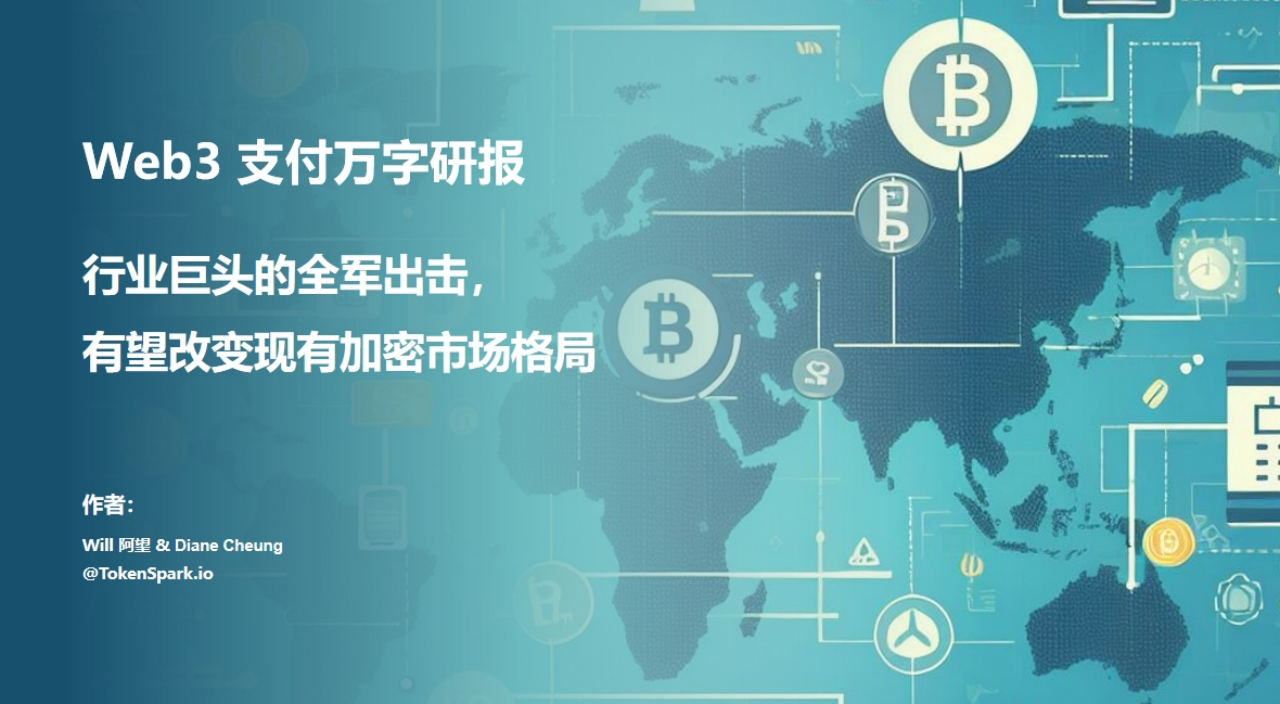
The emergence of blockchain and cryptocurrency technologies not only enables people to purchase NFT digital artworks, interact with players in the Metaverse, and earn money through GameFi gameplay, but it also offers the most fundamental decentralized peer-to-peer payment solutions. These fast, convenient Web3 payment solutions are changing the way we make payments today, and even the entire financial market.
Since PayPal launched its stablecoin, PayPal USD, in August 2023, we've observed numerous industry giants officially announcing their expansion into Web3 payments or integrating Web3 payment channels. It seems like a full-scale deployment into the Web3 payment sector is underway. We can see MetaMask collaborating with Mastercard to launch a fully blockchain-based payment card; X is applying for a payment license intending to incorporate Dogecoin into its payment system (rumored); and the VISA USDC settlement blockchain payment network, among other significant moves by industry leaders.
Given that Web3 payments encompass nearly all the infrastructure in the industry, including payments, stablecoins, wallets, custody, trading, etc., it's crucial for all participants in the Web3 ecosystem to understand the wide range of use cases and potential advantages of Web3 payments.
This article will briefly outline the concept and path of Web3 payments, and then, from the perspectives of business and legal compliance, discuss why Web3 payments are expected to reshape the crypto market landscape. It is hoped that this article can be of assistance in this regard, and discussions are welcome.
Traditional payment systems and Web3 payments are not isolated from each other; instead, they are moving towards each other. Fiat currencies and cryptocurrencies are continuously interacting and gradually merging into stablecoins, central bank digital currencies (CBDCs), and other practical use cases.
Bitcoin was designed to facilitate a decentralized peer-to-peer electronic cash payment system, from which Web3 payments evolved. Currently, Web3 payments can be broadly categorized into two types: fiat currency transactions, and cryptocurrency payments (on-chain, off-chain);
Industry giants such as PayPal, Coinbase, MetaMask, Visa, and Mastercard are gradually opening up/accessing Web3 payment services and scenarios, including wallets, custody, payments, transactions, and stablecoins, eventually covering their entire ecosystem to form their own closed-loop ecosystems;
The infrastructure for Web3 payments is gradually taking shape, involving linking wallets, custody, and stablecoins. However, what's more crucial is how to construct payment scenarios. Imagine how X (Twitter), Telegram, MetaMask, and PayPal will each develop their vast crypto ecosystems. In such a context, the existing landscape of the crypto market is bound to change;
Compliance is the foundation of the payment industry. The cross-regional and cross-scenario complexity of Web3 payment services poses significant challenges to regulatory compliance. However, as cryptocurrency regulation becomes clearer, it is expected to further increase the adoption of cryptocurrencies and promote the rapid development of the Web3 payment industry.
From the perspective of the monetary system, the Bank for International Settlements (BIS) believes that the key to the development of currency after digitalization is tokenization. Tokenization can significantly enhance the capabilities of the monetary and financial systems, and the future monetary system is expected to unleash new economic growth momentum through tokenization.
The greatest opportunity for cryptocurrencies may not lie in viewing them as cryptocurrencies, but in seeing them as a new payment method. Some believe that the killer application for Web3 has yet to arrive, but it might have already quietly made its entrance: it's payments!
1. Overview of Web3 Payments
In simple terms, Web3 payments refer to a payment method based on blockchain and cryptocurrency technologies. However, due to the unique characteristics of blockchain and cryptocurrencies, Web3 payments encompass more than just the payment aspect.
Cryptocurrencies like Bitcoin have multidimensional attributes.It is not only a form of payment but also an innovative technology, a means of storing value, and a financial infrastructure in the form of a distributed ledger. Additionally, it can serve as a unit of account in transactions, marking value.
Traditional payment systems and Web3 payments are not isolated from each other; instead, they are moving towards each other in a bidirectional manner. Fiat currencies and cryptocurrencies are continuously interacting and gradually merging into practical applications such as stablecoins and central bank digital currencies (CBDCs). Web3 payments are redefining our methods of payment and the financial system as a whole.
1.1 Traditional Payment
Let's first look at traditional payment methods. Payment is the act of transferring currency (or its equivalent) or credit from the payer to the payee. It is a process where the flow of information and funds are matched to complete the delivery of money and goods.The essence of payment is the transfer of funds.
Broadly speaking, payment methods include both cash and electronic money. There are generally four ways to transfer funds: cash payments; bank account transfers; debit card transfers; and credit card payments. Among these, the last three, which are forms of electronic money, require a centralized financial system like a bank to complete the transfer of funds. If the bank is unable to directly complete the payment, the involvement of a third-party payment institution is necessary.
Based on the currency used for payment, transactions can be categorized into domestic and cross-border payments. Given that Web3 payments are conducted on the blockchain, enabling transactions across different currencies (fiat vs. cryptocurrency) and regions, they can be considered a form of cross-border payment.
The cross-border payment industry chain involves numerous participants, including customers, commercial banks, third-party account/sales end payment institutions, clearing institutions, merchants, and more. The entire industry chain can essentially be divided into three levels: The first level consists of users and merchants, who are the source and terminal of payments, respectively; the second level comprises payment service institutions, such as banks and third-party payments; the third level is the cross-border payment network, which is the foundational support for cross-border payments, such as SWIFT and SEPA, among others.
The diagram below illustrates the architecture of cross-border payments:
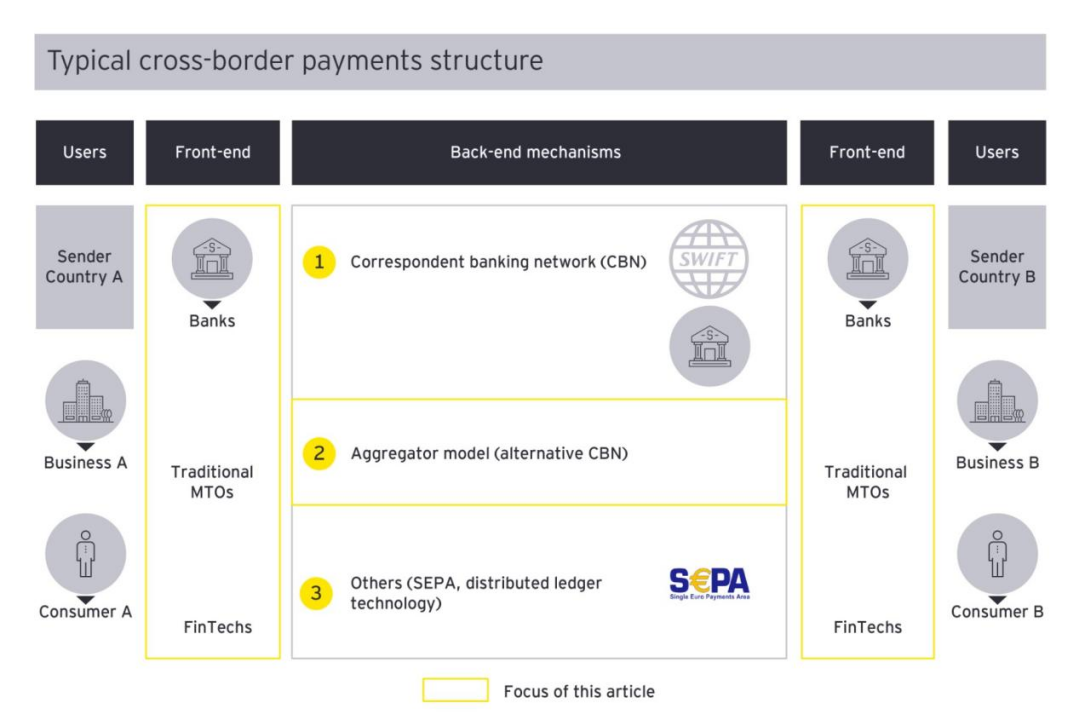
Based on the type of cross-border payment service providers, they can be categorized into bank wire transfers, specialized remittance companies, card-based payment clearing institutions, and third-party payment organizations. The following examples will compare these with Web3 payments that are settled using blockchain technology.
1.1.1 Cross-border payments between banks
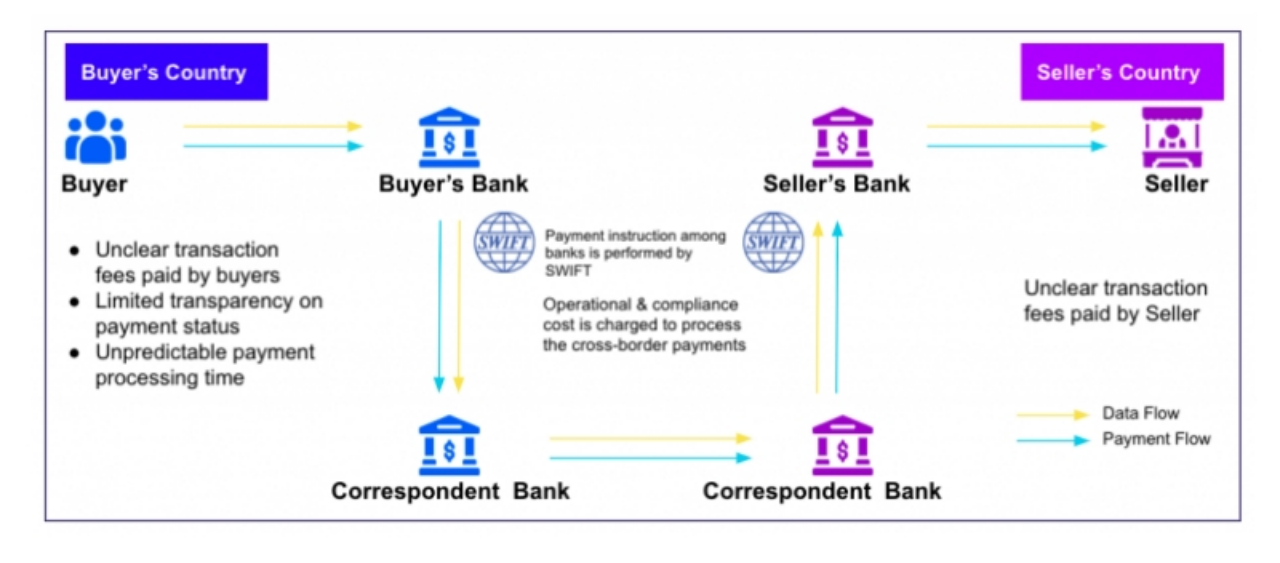
In the early days, cross-border payments were primarily conducted through banks, such as the earliest appearance of bank wire transfers, which were mainly used for inter-bank transactions, import and export trade, and other cross-border payments. This method of payment required navigating through a complex network of banks and could take several days or even weeks to complete. The process might involve the exchange of multiple currencies, and the fees were relatively high.
Traditional cross-border payments through banks primarily rely on the SWIFT network. SWIFT does not hold funds or manage accounts for users but provides a communication information network and exchanges standardized financial messages. SWIFT can be seen as a network that connects nearly all mainstream banks globally, allowing them to complete foreign exchange transactions using a common language. However, SWIFT has its drawbacks. A transaction can easily experience delays or even fail if it goes through multiple intermediary banks or encounters anti-money laundering checks. Additionally, there are issues like exchange losses.
As illustrated above, when a commercial account relationship is established between the receiving bank and the paying bank, the payment made by the user is directly transferred through the bank's commercial account, with the bank charging a corresponding fee. However, when there is no commercial account relationship between the receiving bank and the paying bank, an intermediary bank is required to complete the transaction. The intermediary bank will charge additional fees, and the payment arrival time will also be extended due to the increase in transaction parties.
Cross-border payments in banking are subject to strict regulation, with varying policies across different countries and regions, which imposes certain limitations on cross-border payments. Additionally, most cross-border payments through banks come with stringent KYC/AML requirements, necessitating the opening of an account before completion, thus making it relatively costly.
1.1.2 International Card Organizations
Similar to SWIFT, international card organizations also serve as a major network for traditional cross-border payments, but they focus more on the merchant acquiring scenario (where merchants charge buyers' accounts). These acquiring methods are diverse, and the currency exchange process is directly completed during the payment process, settling in the local currency for merchants.
Card organizations are international regional payment information processing networks, currently comprising six major global networks: VISA, Mastercard, China UnionPay, American Express, JCB, and Discover. Cross-border payments processed by international card organizations typically require T+1 day or longer to complete, meaning they take at least T+1 day to reach the merchant's account. The operation of payments through international card organizations also requires a license and is subject to the regulatory policies of different countries.
1.1.3 Third-Party Cross-Border Payments
With the development of e-commerce and internet technology, electronic transfers have become a popular method for cross-border payments. This type of cross-border payment is generally provided by non-bank institutions (such as Alipay, PayPal, etc.) as third-party payment providers offering full or partial fund transfer services. These third-party payment institutions play a significant role in cross-border e-commerce retail, remittances, import and export business, and overseas mobile payments.
Third-party cross-border payments require integration with international card organizations or banks for clearing and settlement to complete the payment. The currency exchange process in cross-border payments is mainly carried out by banks. Third-party payment platforms often have a custodial function, meaning the funds can be deposited in the third-party payment account and transferred to the seller's account once the transaction is confirmed.
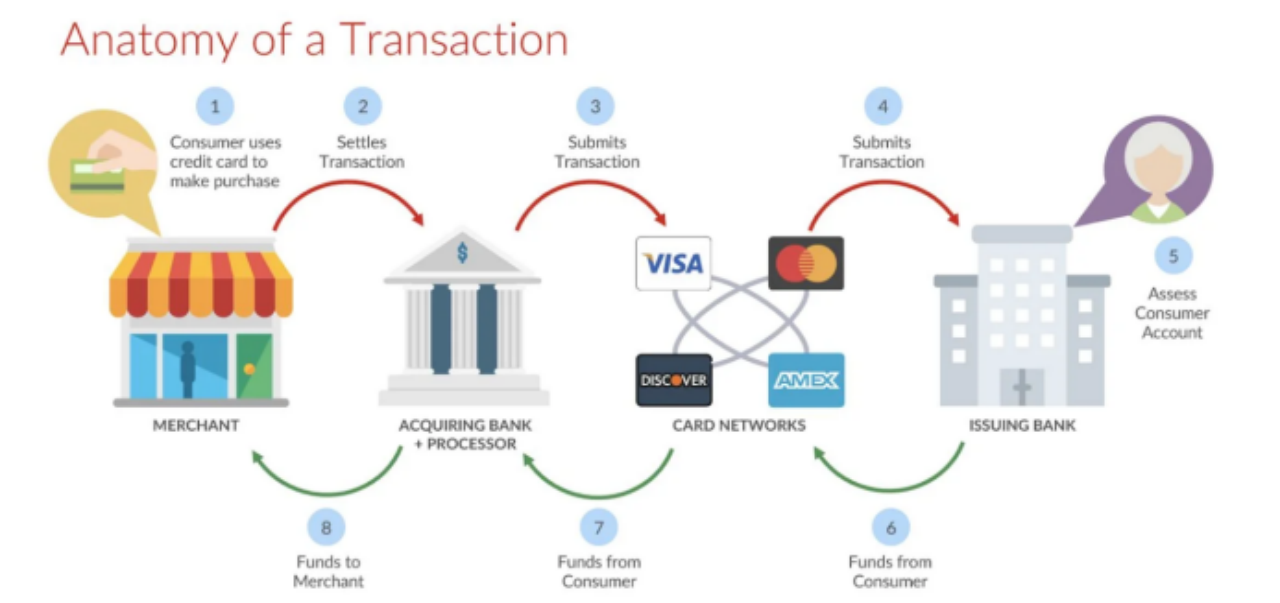
As shown in the diagram, in a cross-border e-commerce scenario, the user side is the starting point of the fund transfer. The third-party payment institution connects the user's bank account with the issuing bank's credit/debit card. After the user makes a purchase, the funds are transferred to the payment channel and connected with the card organization for clearing and settlement. After clearing and settlement, the third-party payment institution transfers the funds to the merchant. When there is an offline shopping scenario, there needs to be an acquiring agent to connect the merchant with the third-party payment institution.
Traditional payment systems have been around for a long time and currently cover most application scenarios with a wide range of functionalities. However, cross-border payments face significant challenges such as high costs, slow speeds, limited access, and a lack of transparency. According to a survey by the Federal Reserve, users' main pain points are centered around two aspects. First, there is a need for faster payment speeds as the current processing times do not meet user expectations, with a desire for 24/7/365 payment services. Second, there is a strong demand for periodic real-time payment scenarios.
1.2 Web3 Payments
Although the current payment methods are rapidly digitizing, the process of transferring funds is very cumbersome due to the large number of participants, and the friction costs are also very significant, resulting in high costs.The improvement of payment experience has always been constrained by various parties, including intermediary agencies, banks, and technology companies.
Bitcoin was designed from the outset to be a decentralized peer-to-peer electronic cash payment system. In 2008, against the backdrop of the global financial crisis, Satoshi Nakamoto published the Bitcoin whitepaper, aspiring to transform the traditional bank-centered financial system and achieve complete financial decentralization. Since its inception on January 9, 2009, Bitcoin has ushered in the era of widespread cryptocurrency adoption.
Bitcoin payments enable direct transfers between users without the need for third-party institutions such as banks, clearing centers, and electronic payment platforms, thereby avoiding high fees and cumbersome transfer processes. Any user with a device connected to the internet can use it without permission.
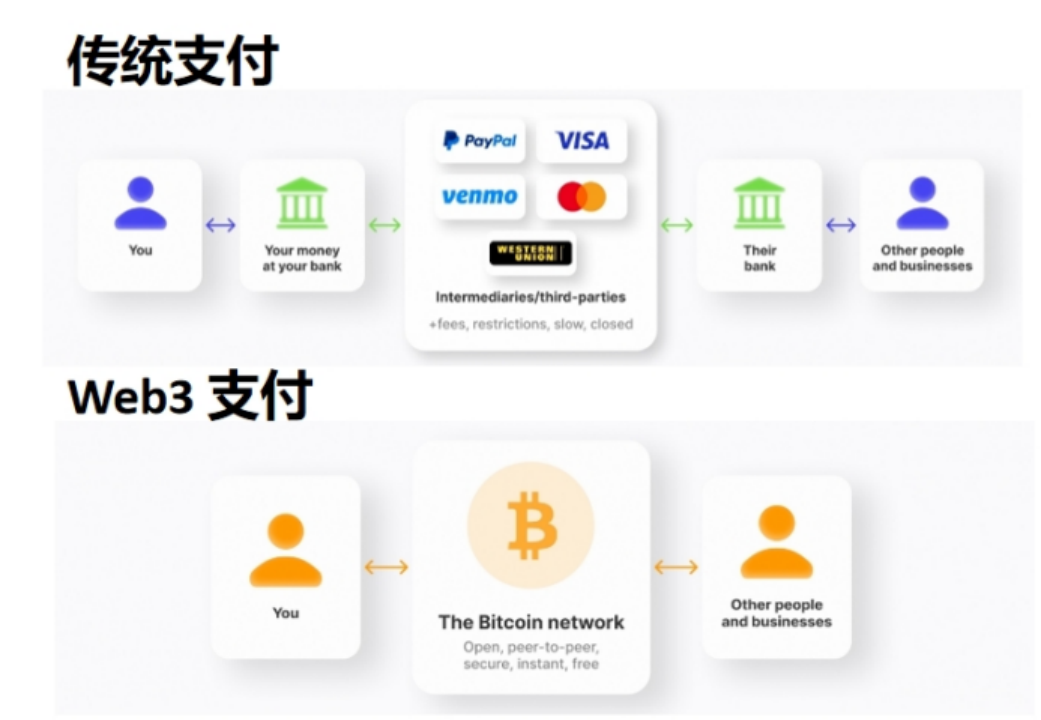
Similar to the Bitcoin payment network, cryptocurrency payments rely on the blockchain network as the backbone infrastructure, allowing cryptocurrencies to be transferred directly between the sender and receiver without any third party, quickly, conveniently, and at a very low cost.
As the acceptance of cryptocurrencies continues to rise, the inevitable interaction between cryptocurrencies and the real-world fiat currencies occurs. In this context, institutions that offer deposit and withdrawal services act as banks in cross-border payments, facilitating the exchange between cryptocurrencies and fiat currencies.
From this, currentlyWeb3 payments can primarily be divided into two types: (1) On-ramp and Off-ramp payments.payments in the context of cryptocurrency and fiat currency exchange;(2) Cryptocurrency payments, including (2.1) native asset payments on the cryptocurrency blockchainIn the realm of blockchain, interactions between two addresses or between cryptocurrencies and on-chain assets (such as purchasing NFTs with cryptocurrencies, or swapping between different cryptocurrencies);And (2.2) traditional physical payment off the cryptocurrency chainThis refers to its role as a medium of exchange when purchasing other goods/services;
Web3 payments connect fiat currencies with cryptocurrencies through deposit and withdrawal payments, allowing the circulation of crypto assets through cryptocurrency payments, thus forming a complete payment loop.
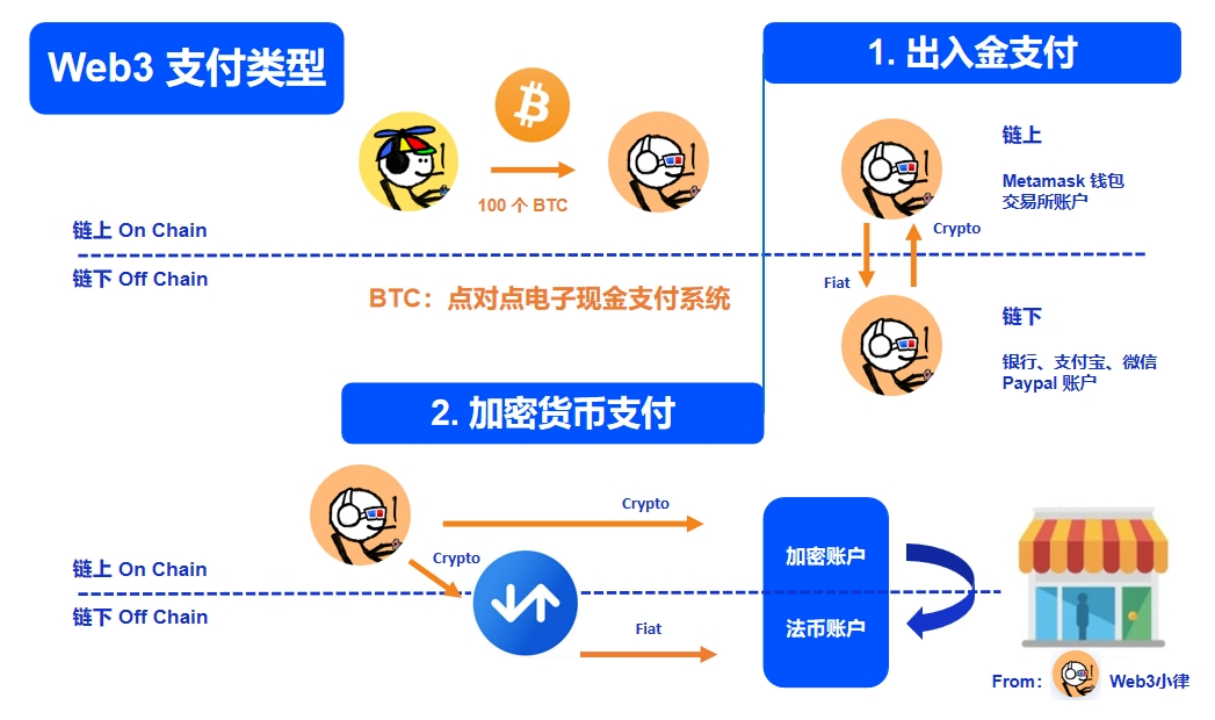
Since cryptocurrency payments are conducted on the blockchain, they are essentially not limited by geography. Regulatory frameworks in various jurisdictions are gradually being improved to accommodate this. However, the process of depositing and withdrawing funds involves fiat currency transactions, and thus, it is subject to existing financial regulations.
1.3 Advantages of Web3 Payments Over Traditional Payments
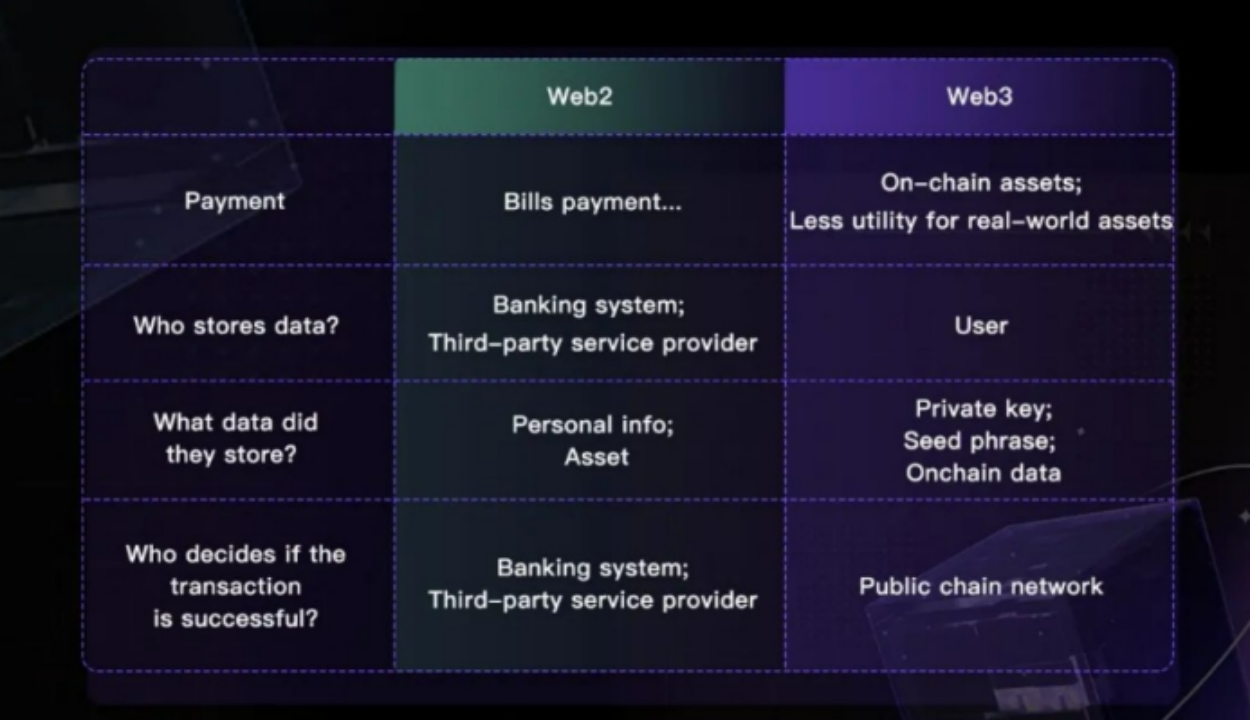
Traditional payment is a system based on account systems, where the transfer of value is recorded in the accounts of intermediary institutions (such as banks, third-party payment companies). Due to the involvement of numerous participants, the process of fund transfer is very cumbersome, and the frictional costs are also very significant, resulting in high costs.
In comparison,Web3 payments represent a payment system based on a value-based or token-based system, where the transfer of value is stored in the distributed ledger on the blockchain by the users themselves. Web3 payments rely on blockchain networks as their core infrastructure, allowing for the transfer of cryptocurrencies between the sender and receiver. This system can address issues in traditional payments such as high fees, low efficiency in cross-border transfers, and high costs.
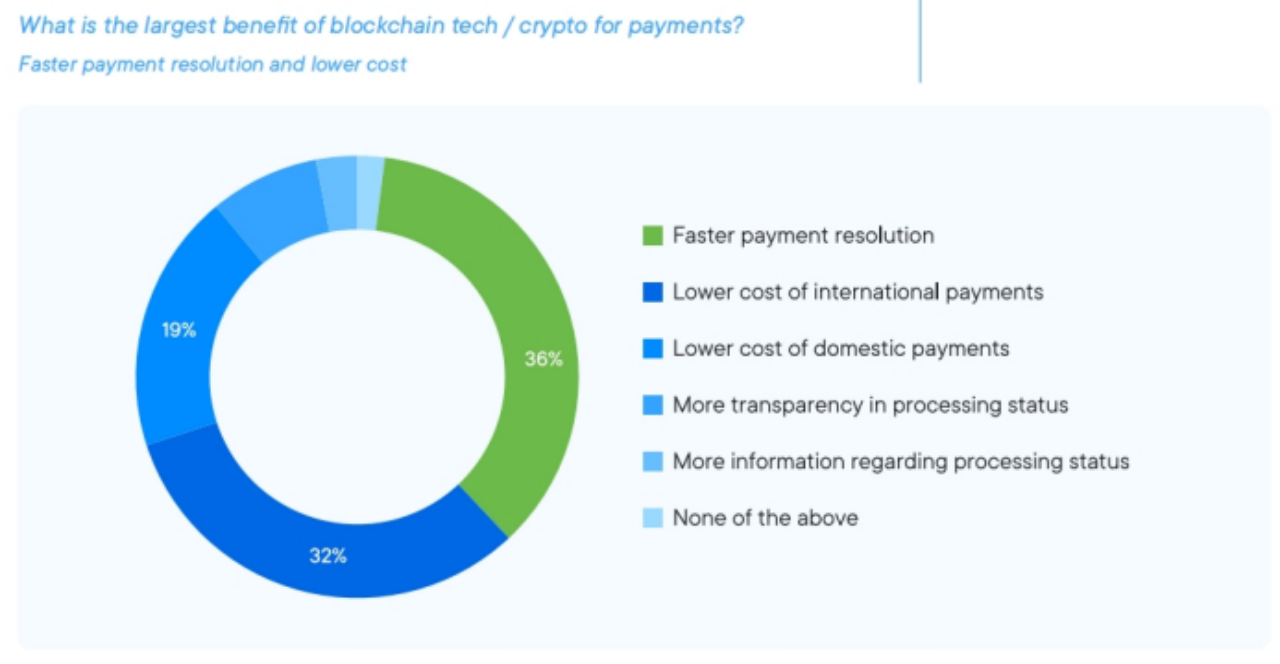
Compared to traditional payment methods, what are the advantages of Web3 payments?
Firstly, relying on blockchain technology can effectively reduce the cost of trust between trading parties, making payments more direct, faster, and safer. The functionality of smart contracts enables programmable payments and automated execution, enhancing the efficiency and credibility of payments.
Secondly, the timeliness of cryptocurrency payments currently has a significant advantage over traditional payments, especially in the realm of cross-border payments. This characteristic is likely to be a key driver in the development of cryptocurrency payments and will also serve as a major force in propelling the upgrade of traditional cross-border payment technologies.
Moreover, due to its decentralized nature, Web3 payments simplify the processes built on centralized clearing institutions, reducing friction costs, especially significantly enhancing the efficiency of cross-border payments and speeding up the settlement process.
Various signs indicate that traditional cross-border payments and Web3 payments are not completely disconnected; instead, they are moving towards a mutual convergence from various aspects. This is reflected on one hand by the accelerated application of blockchain technology in the traditional payment industry, with multiple countries experimenting with CBDCs, and major players in traditional payments like SWIFT, VISA, and PayPal exploring Web3 payment solutions. On the other hand, it is also evident in Web3 payment projects actively seeking deep collaboration with traditional financial institutions and third-party payment providers, as well as exploring the accelerated application of compliant stablecoins.
Despite facing challenges in technology, user acceptance, and security compliance, Web3 payments still hold significant importance for the cryptocurrency industry and the broader traditional financial sector.
II. The Main Pathways of Web3 Payments
Currently, Web3 payments can mainly be divided into two types: (1) On Ramp & Off Ramp payments; (2) Cryptocurrency payments (including payments in native on-chain scenarios, as well as payments between on-chain and traditional off-chain entities).
Web3 payments connect fiat currencies with cryptocurrencies through deposit and withdrawal payments, allowing the circulation of crypto assets through cryptocurrency payments, thus forming a complete payment loop.
Given the current small size of native assets in the cryptocurrency market and the limited payment scenarios, most of the payments discussed within the Web3 industry today are related to the exchange of funds between fiat currencies and cryptocurrencies.
2.1 Deposits and Withdrawals
On-ramp and off-ramp transactions are crucial bridges connecting fiat currencies with cryptocurrencies, creating a complete payment loop. Apart from OTC/P2P methods, all other on-ramp and off-ramp processes require the involvement of third-party payment institutions.
2.1.1 Deposit and Withdrawal Payment Process
The flow of funds behind deposit and withdrawal payments: **Users transfer fiat currency through payment channels to liquidity providers behind third-party payment institutions (Crypto Liquidity Provider), and these liquidity providers act more like merchants in traditional third-party payment scenarios, transferring the 'product' of cryptocurrency via the blockchain to the user's address, while also providing cryptocurrency liquidity to the third-party payment institutions.** Withdrawals work in the reverse manner.
These liquidity providers are typically centralized exchanges (such as Coinbase Prime, Binance, Kraken) or stablecoin issuers (such as Tether and Circle), or crypto-friendly banks (such as the now-defunct Silvergate bank and Signature bank). Liquidity providers play a crucial role in the deposit and withdrawal process, acting as a bridge between fiat currency and cryptocurrency.
2.1.2 Main Payment Methods for Deposits and Withdrawals
Centralized Exchange
Due to the nature of centralized exchanges also involving the transfer of currency, their functions partially overlap with those of payment institutions. The licenses required for dealing with crypto assets/payments are the same as those needed by payment institutions. Consequently, most centralized exchanges also offer deposit and withdrawal payment services.
In addition, centralized exchanges themselves can also act as liquidity providers. Hence, we observe that most centralized exchanges have their own fiat-to-crypto payment services. Users can directly purchase cryptocurrencies through debit/credit cards or bank transfers, such as Binance Pay, Coinbase Pay, Gate Pay, etc.
Centralized exchanges offer a payment interface for buyers and sellers through the exchange's custodial wallets. Participants can choose to use different accounts within the same custodial wallet or opt for non-custodial wallets. The former option incurs lower fees as it does not involve gas costs.
In addition, in jurisdictions with stricter regulations, centralized exchanges are required to integrate independent payment institutions for deposits and withdrawals as their underlying payment channels to facilitate user transactions. This practice is also applicable to decentralized exchanges, such as Uniswap, which has integrated independent payment institutions like Moonpay and Paypal to support user deposits and withdrawals.
B. Independent Payment Institutions
Independent payment institutions with cryptocurrency transfer capabilities refer to payment institutions (which may also include crypto-friendly banks) that must obtain relevant licenses for cryptocurrency assets/payments in their operating regions.
Among them, MoonPay is currently the leading project in cryptocurrency deposits and withdrawals, positioning itself as the PayPal for Web3, with over 5 million registered users. In terms of coverage, MoonPay supports crypto payments in more than 160 countries and regions, facilitates the exchange of over 80 types of cryptocurrencies and more than 30 types of fiat currencies, and holds payment business licenses in most jurisdictions.
In terms of payment methods, MoonPay currently supports payments through channels such as credit and debit cards, mobile payments, and account-to-account transfers. Payments can be completed by entering the on-chain address and the amount of currency. Coinbase provides liquidity supply for it, and with its comprehensive deposit and withdrawal functions and the first-mover advantage leading to the Matthew effect, it has quickly dominated most of the European and American markets where credit card usage is prevalent, supporting a valuation of 3.5 billion dollars.
Moreover, we observed that the traditional payment giant Paypal, leveraging its robust payment channels, has partnered with stablecoin issuer Paxos to launch the PYUSD stablecoin, venturing into the Web3 payment market. The previously collapsed Slivergate Bank and the forcibly shut down Signature Bank, these crypto-friendly banks, were actually quite significant payment channels for deposits and withdrawals.
C. Other Payment Methods for Deposits and Withdrawals
Other deposit and withdrawal payment methods are essentially integrated payment products based on the two payment methods mentioned above.
Aggregated payment products integrate multiple independent payment gateways, allowing users to benefit from the rates and quotes of different independent payment gateways for their transactions. MetaMask is the most typical example of such aggregated payments, with other well-known leading projects including TransitSwap and KyberSwap.
Cryptocurrency retail terminals such as ATMs and POS systems are emerging alongside the growth of the cryptocurrency industry. Beyond online payments, physical retail terminals for cryptocurrencies have been introduced. Cryptocurrency ATMs allow for the offline purchase of cryptocurrencies using cash. ATM providers purchase liquidity from third-party suppliers and pay the users. The distinctive feature of this payment method is its anonymity; users can buy cryptocurrencies with minimal or no need for identity verification, providing little personal information. However, the downside is the high transaction fees, ranging from 5% to 20%. Bitcoin Depot is a leading project in this field.
Cryptocurrency POS systems offer an alternative channel for offline cryptocurrency payments. Users can make payments in cryptocurrency through POS terminals, while merchants receive fiat currency directly, facilitating user withdrawals. This type of payment also requires a license, but the withdrawal fees are generally lower compared to ATMs. Pallapay is one of the projects that provide such solutions.
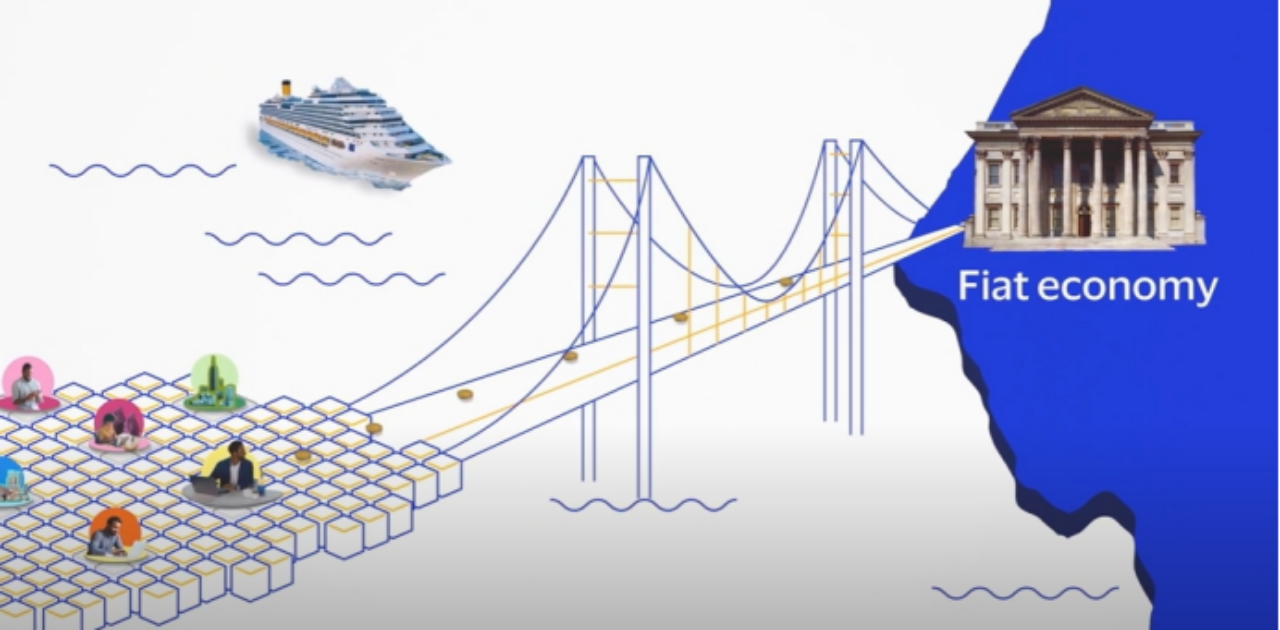
Overall, there are currently a variety of options available for Web3 payments, but when it comes to deposits and withdrawals involving the conversion between fiat currency and cryptocurrency, operators generally need to apply for operating licenses by region. The fees generated by payments vary slightly due to the different business models of the payment methods.
In addition to deposit and withdrawal payments, some centralized exchanges and payment institutions have collaborated with card organizations like Visa and Mastercard to issue debit and credit cards. These cards possess dual functionalities, enabling both deposit and withdrawal payments as well as cryptocurrency payments.
2.2 Cryptocurrency Payments
As the acceptance of cryptocurrencies continues to grow, Web3 payments are making their way into traditional markets such as e-commerce (for online shopping), the gig economy (for contracts and freelancers), cross-border remittances, travel bookings, and online gaming (for in-game item exchanges). They utilize cryptocurrencies for online spending and remittances, instead of relying on the outdated infrastructure of traditional banks or third-party payment institutions.
Currently, cryptocurrency payments are primarily divided into two categories: one involves payments between traditional off-chain entities, and the other involves payments within native on-chain scenarios.
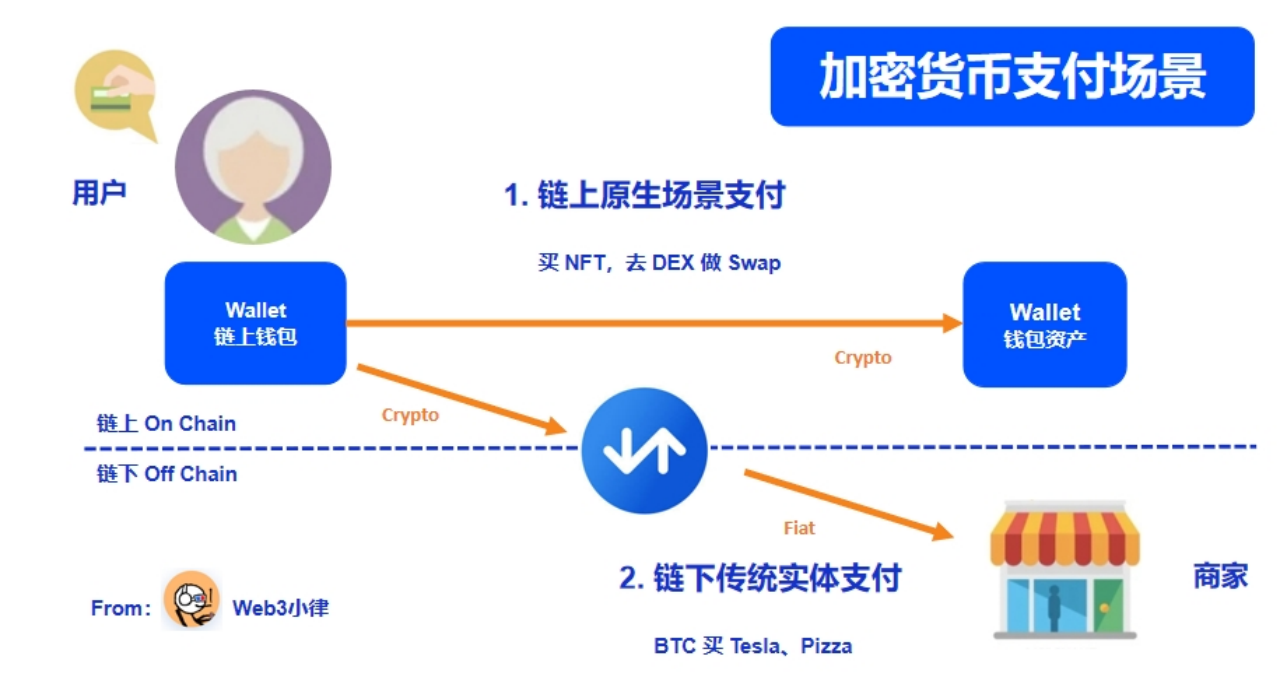
2.2.1 Cryptocurrency Payments—Off-Chain Traditional Physical Payments
According to a report by PYMNTS and BitPay in 2022, which surveyed over 2,330 online merchants with annual sales exceeding $250 million, approximately 85% of large retailers (with annual revenues over $1 billion) now offer cryptocurrency as a payment option. Among all the merchants surveyed, half have already adopted cryptocurrency payments, and among those who haven't, 42% are planning to do so. The report also found that most merchants use non-native crypto wallets, such as PayPal and Venmo, to support crypto payments.
To meet the growing demand for Web3 payments, leading payment giants such as Mastercard, Visa, PayPal, Stripe, and Venmo are partnering with cryptocurrency companies to offer millions of users the option to use cryptocurrencies as a means of payment. Most major retailers, including Overstock, Microsoft, Expedia, and Starbucks, have also integrated crypto payments, allowing their customers to directly purchase digital and physical goods with cryptocurrencies. Other major companies that have embraced crypto payments include the popular streaming company Twitch, Norwegian Air, Etsy, and Burger King.
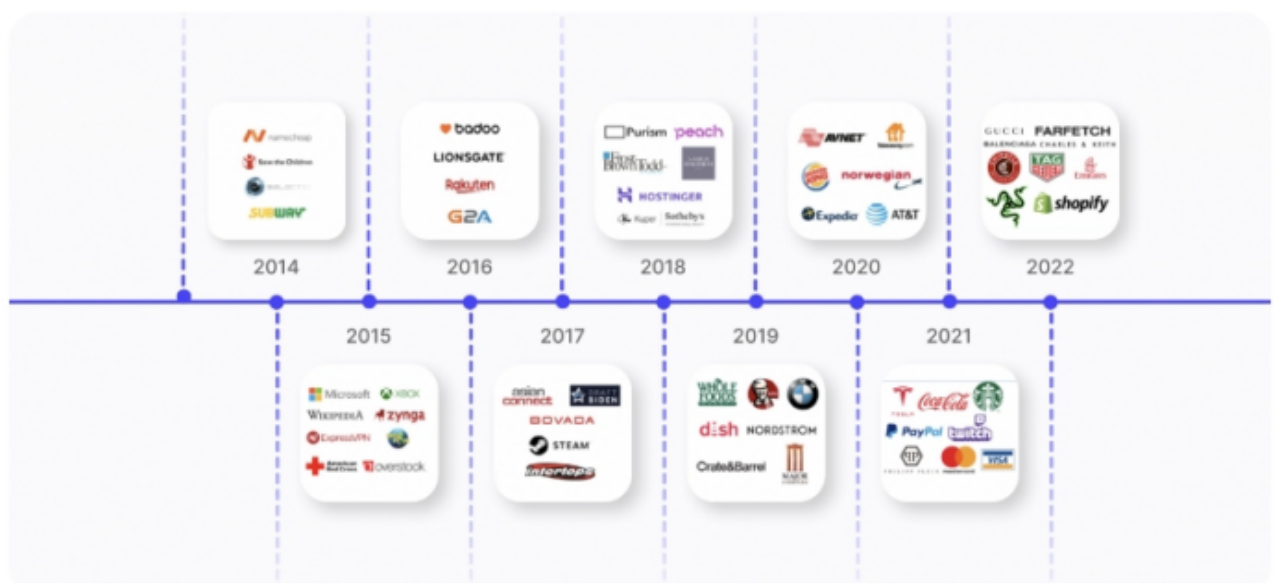
In terms of payments between traditional entities via blockchain, we simulate a scenario where a user spends cryptocurrency, and the merchant receives fiat currency. The flow of funds involves a third-party payment institution that first converts the cryptocurrency into fiat currency through deposit and withdrawal processes, and then makes the fiat currency payment to the merchant.
The most common solution currently available involves the issuance of encrypted bank cards. Centralized exchanges or wallet companies often collaborate with card organizations like Visa and Mastercard to issue encrypted debit/credit cards. Users can make online purchases or swipe their cards offline as long as they hold cryptocurrencies in their platform accounts. During the actual payment process, the issuing company will convert the cryptocurrency into the local fiat currency through a withdrawal payment channel before paying the merchant. We see that the centralized exchange Crypto.com has issued the Crypto.com Visa Card debit card in partnership with Visa. In addition to the functionality of fiat currency payments, it also provides users with the ability to make payments in on-chain cryptocurrencies.
2.2.2 Cryptocurrency Payments - Payments in Native On-Chain Scenarios
In terms of payments in native blockchain scenarios, users pay with cryptocurrency, and merchants accept cryptocurrency.This approach cannot be simply understood as merely peer-to-peer payment transfers based on blockchain technology. It also needs to take into account the trust issues encountered in real-world payment scenarios, which necessitates the implementation through third-party payments.
Taking the case of online shopping as an example, in the context of solving trust issues (trust chains among friends), transactions can be directly facilitated through blockchain peer-to-peer transfers, encompassing user payment, merchant shipping, and user receipt. However, in an online shopping platform without a foundation of trust, who ensures that the merchant will ship the goods after the transfer, and that the received goods match the actual products?
Similarly, we can achieve peer-to-peer transfers between family and friends through the blockchain network. However, what should we do if the transaction counterpart is a stranger? Therefore, we also need a set of account systems linked to the blockchain's settlement system to facilitate the flow of physical goods offline and payment settlements online.
Therefore, third-party payment institutions that offer cryptocurrency payment products are needed to address the issues mentioned above. This includes the cryptocurrency payment protocol shown in the diagram, the payment core system, front-end product interaction, and the corresponding support modules. We can see Ripple and Stella's exploration in this area.
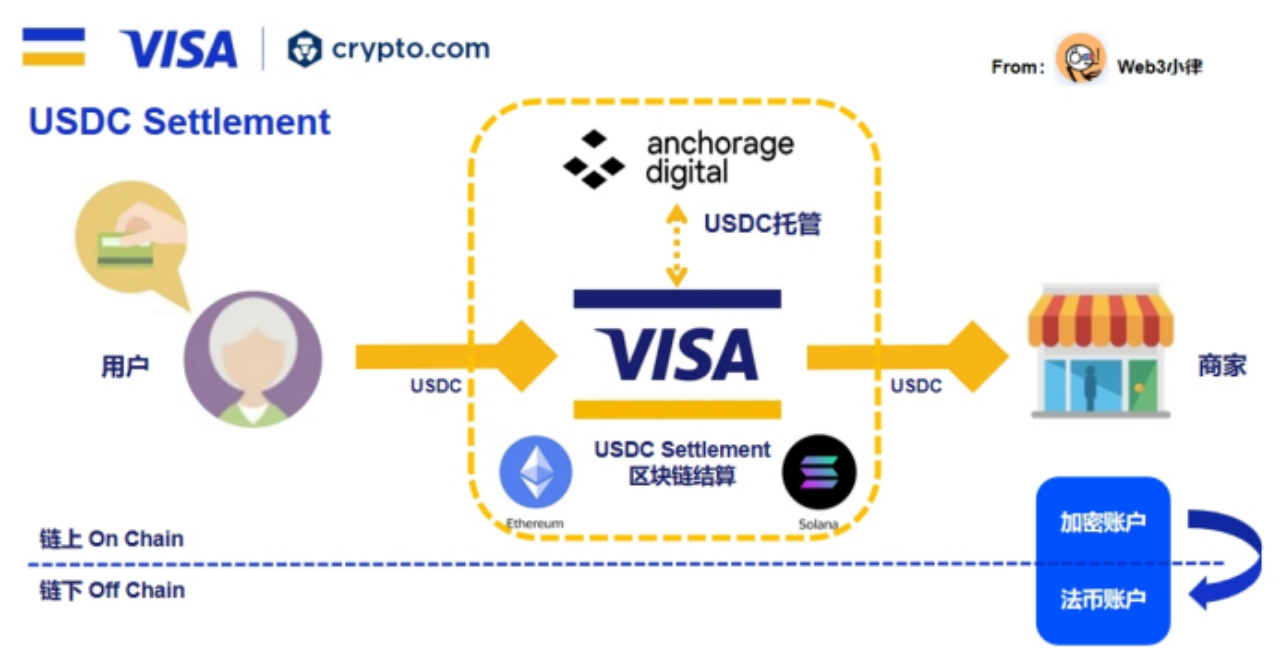
Visa recently introduced a settlement solution based on the stablecoin USDC, which has been applied in the case of Crypto.com. Previously, in scenarios where users spent cryptocurrencies and merchants received fiat currency, Crypto.com had to convert the cryptocurrencies paid by users into fiat currency and then pay the merchants through traditional payment channels. Settling through traditional payment channels means increased participants, transaction fees, costs, and complexity, and it restricts Crypto.com from executing settlements outside of banking hours.
Through Visa's USDC settlement scheme, the need for currency exchange and traditional payment steps in transactions is directly eliminated, enabling real-time, global settlements 24/7/365 via blockchain. This flexible settlement method, which does not require currency exchange, opens up new business scenarios for Crypto.com, such as merchant cryptocurrency payment gateways and blockchain-based cross-border payments.
Visa's USDC settlement solution can also be applied to cross-border remittances. The cross-border remittance market, currently valued at nearly $100 billion, is plagued by the high costs of traditional payment methods, which charge up to 8% of the total transaction amount in fees. In contrast, Web3 cross-border remittance products like Strike's Send Globally leverage the Bitcoin Lightning Network to offer an affordable alternative to traditional cross-border remittances, with fees ranging from only 0.01% to 0.1% of the transaction amount.
This settlement method, combined with the use of stablecoins, can reduce the cost of traditional cross-border payments by 80%. This means that for a $500 remittance, the transaction cost of on-chain cryptocurrency payments and cash in/out payments is only $4.8, significantly lower than the average cost of cross-border remittances, which hovers around $20. In 2022, cross-border remittances to laborers neared $800 million, and remittances based on Web3 payments could save the industry between $40 billion and $64 billion in costs annually.
3. Industry Giants Lay Out Plans for Web3 Payments
Industry giants are gradually opening up and integrating Web3 payment services and scenarios around their core businesses such as trading, payments, communication, and social networking. This includes wallets, custody, payments, transactions, and stablecoins, ultimately covering their entire ecosystem to form a logical loop. The following outlines the strategies of Paypal, Coinbase, and MetaMask in this area.
3.1 PayPal's Web3 Payment Strategy: Payments, Wallet Custody, and Stablecoins
In the previous article, "Paypal's Stablecoin Hopes to Lead the Crypto Industry Towards Mainstream," we introduced PYUSD, a stablecoin launched by Paypal on August 7, 2023. As the only stablecoin supported within the PayPal ecosystem, it aims to connect PayPal's existing 431 million users, providing a seamless bridge between fiat currency and cryptocurrency for consumers, merchants, and developers in the Web2 space.
3.1.1 Implementation Path for Deposit and Withdrawal Services
By reviewing the Paypal CryptoCurrency user agreement, we can see that the PYUSD stablecoin plays a crucial role as a bridge in facilitating payments between Web2&3, Paypal accounts, and crypto custody wallet accounts.
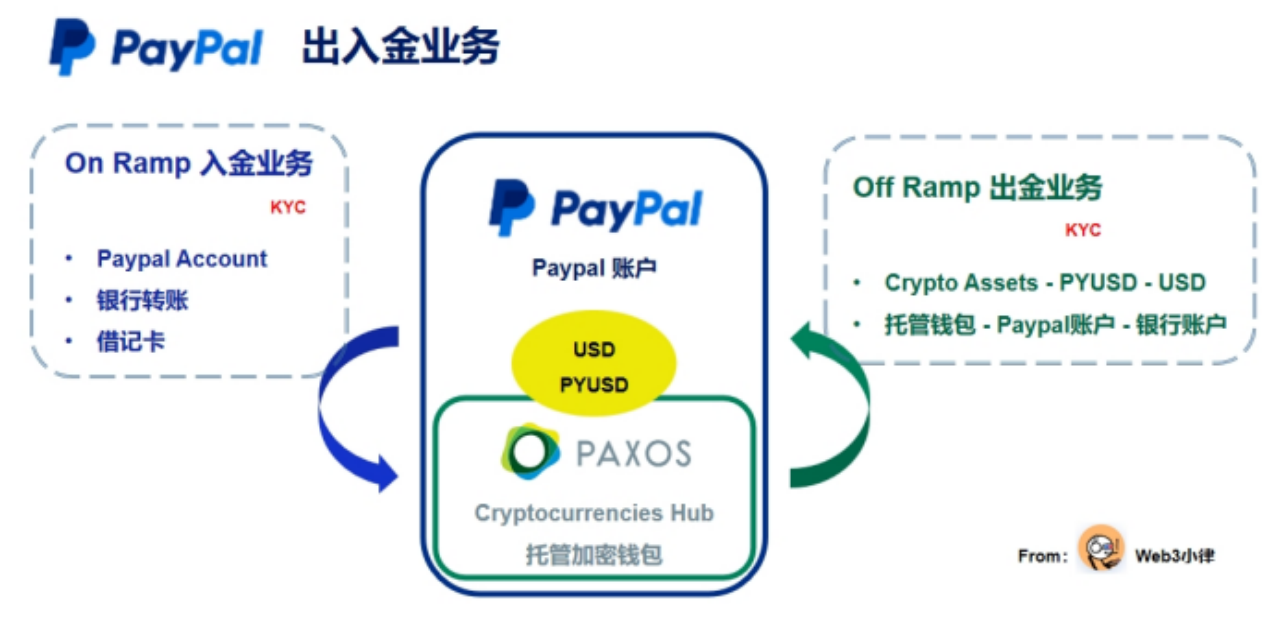
As illustrated above, Paypal uses the PYUSD stablecoin as a bridge for exchanges between fiat currency and cryptocurrency. Whether it's for deposit services, withdrawal services, or crypto payment services, transactions are completed through the USD - PYUSD - Crypto Asset chain, and vice versa. For instance, in scenarios where cryptocurrency is used to pay for merchant services, the first step is to sell the Crypto Asset for PYUSD/USD, which is then used to make payments to the merchant in PYUSD/USD.
For fiat currency transactions, PayPal uses its accounts, while for cryptocurrencies, PayPal facilitates this through the creation of a Cryptocurrencies Hub wallet under the PayPal account. This wallet is managed by PYUSD issuer Paxos, meaning users relinquish control of their assets (private keys). The PayPal User Agreement explicitly states: "You will not hold the digital Crypto Assets themselves in your Crypto Asset balance / You do not own any specific, identifiable, Crypto Asset."
From this, we see thatPaypal has laid out a framework for Web3 payments by bridging the gap between fiat and cryptocurrency through payment channels, issuing stablecoins as a medium of exchange, and establishing a Paypal account wallet system. This allows for a logical closed loop within its own ecosystem.
Building on this foundation, Paypal can leverage its strengths in the payment industry to extend deposit capabilities to cryptocurrency wallets like MetaMask and Ledger, as well as centralized exchanges such as Kraken. Additionally, in the withdrawal feature announced by Paypal on September 12, 2023, support is also extended to wallets, DApps, and NFT market platforms.
With channels, tools, and infrastructure all in place, the key is how to guide Paypal's existing 431 million users into Web3, leading Web3 towards true mass adoption.
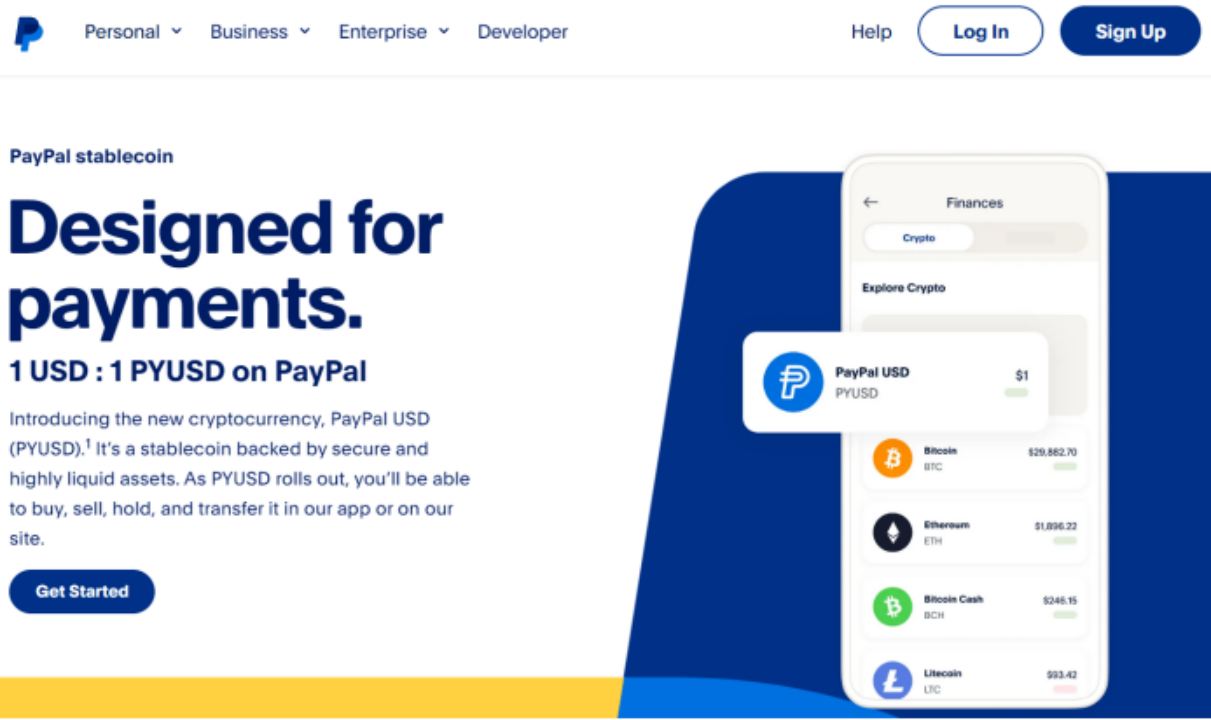
3.1.2 Traditional Payment Companies Poised for Action
We've observed that Paypal's approach is particularly well-suited for traditional payment companies to emulate, such as Stripe and Square, which are already engaged in deposit and withdrawal services, as well as transaction exchanges. For instance, Stripe announced in December 2022 that it would offer cryptocurrency deposit services, and Block (the parent company of Square) offers BTC trading services through its Cash App, in addition to its basic peer-to-peer payment functionality.
Traditional payment companies have essentially achieved compliance in local payment operations and obtained the necessary qualifications and licenses. The question of when and how they will venture into Web3 payments is merely a matter of timing and pace. In contrast, newcomers like X (formerly Twitter) are actively applying for Money Transmitter Licenses (MTL) across various states in the U.S. to meet the requirements for compliant payments.
3.2 Coinbase's Web3 Payment Layout - Trading, Custody, and Payments
Coinbase, as the world's most compliant centralized exchange, offers many regulatory paths worth emulating. We observe thatCoinbase, by strategizing around Web3 payments, can create a logical closed loop within its own ecosystem. This includes payment channels for deposits and withdrawals, Commerce merchant payment solutions, stablecoin transaction mediums (USDC), cryptocurrency custody wallets and non-custodial Wallets, as well as the core trading functionalities of the exchange itself.
3.2.1 Trading as the Core, Payment as the Auxiliary
Although centralized exchanges obtaining payment licenses is primarily for the compliance of their own trading operations, acquiring these licenses also opens up funding channels and payment gateways. Due to regulatory uncertainties, overly relying on third-party funding and payment channels, such as the previously collapsed Slivergate Bank and Signature Bank which was forcibly liquidated by regulators, can lead to business instability. Therefore, we see many exchanges developing their own payment services, such as Binance Pay, Coinbase Pay, Gate Pay, etc.
In the Licenses & Disclosures section, we see that Coinbase has obtained money transmission licenses (MTL) in most states in the United States. Notably, Coinbase was granted a BitLicense by the New York State Department of Financial Services (NYDFS) in 2017, becoming the first regulated Bitcoin exchange in the US, capable of offering services such as buying, selling, receiving, and storing Bitcoin for users in New York.
Outside the United States, Coinbase is actively expanding into international markets and has successively obtained the EMI license in the UK, the VASP license in Ireland, the VASP license in Germany, and the DPT license in Singapore. Consequently, Coinbase, with its trading operations as the entry point, is gradually extending its trading services and payment channels to cover numerous jurisdictions worldwide.
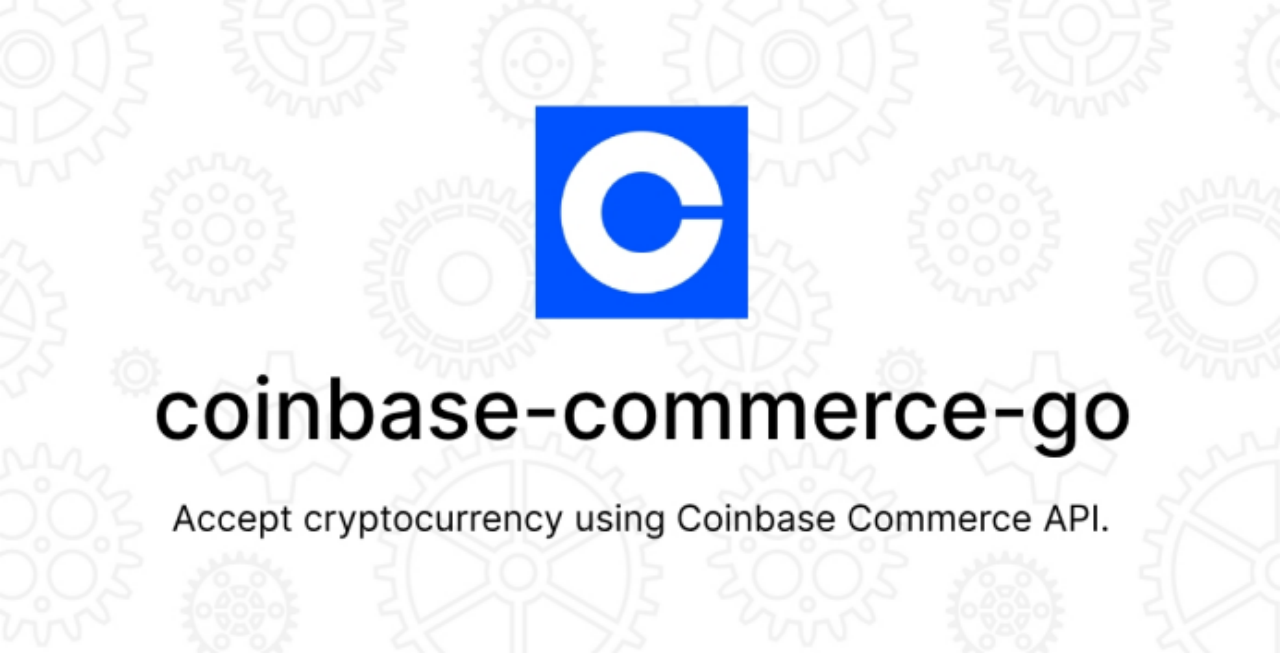
3.2.2 Custodial Services and Non-Custodial Wallets
Coinbase Custody Trust Company, LLC, regulated by the New York State Department of Financial Services, is the principal entity through which Coinbase offers custodial services. We observe that existing Bitcoin spot ETFs primarily partner with Coinbase for asset custody.
According to data from CoinGecko, an analysis included in the ETF filing submitted by BlackRock estimates that 56% of the $129 billion in Bitcoin transactions in the United States were conducted on Coinbase. As the development of Bitcoin spot ETFs progresses, this percentage is expected to increase further. Consequently, Coinbase stands to gain significantly and become the biggest winner in this competition.
For non-custodial wallets like Coinbase Wallet, since users independently control their assets (private keys) and interact directly with the payment system, Coinbase Wallet itself, similar to MetaMask, would not be classified as an MSB (Money Services Business) by FinCEN.
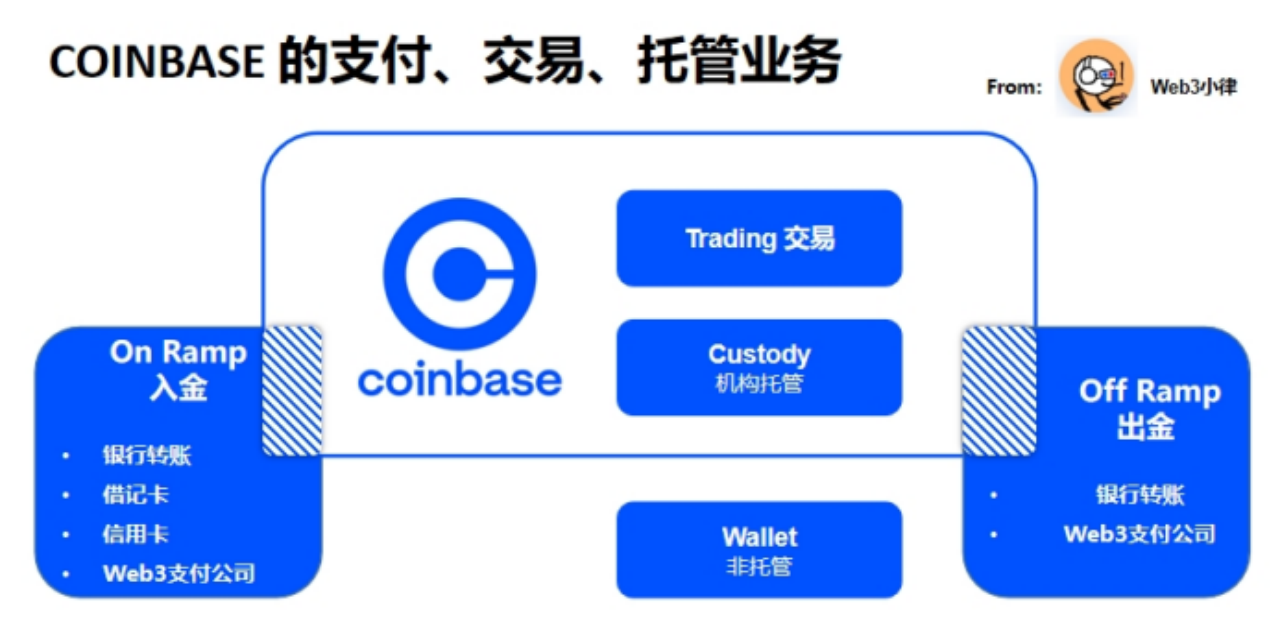
From this, we observe that Coinbase, leveraging its compliance advantage in trading operations, has established a seamless payment channel for deposits and withdrawals, a stablecoin trading medium (USDC), crypto asset custody wallets and non-custodial Wallets, as well as the core trading functionalities of the exchange itself, thereby creating a logical closed loop within its own ecosystem.
Web3 payment services are good, but the key lies in the exchange's core business and profit contribution of Coinbase.
3.3 MetaMask's Web3 Payment Layout - Wallet and Aggregation
Over the past year, we've observed MetaMask continuously rolling out new features. The current MetaMask Portfolio DApp now integrates functionalities such as Sell, Buy, Stake, Dashboard, Bridge, and Swap, facilitating users in conveniently managing their assets and executing unified on-chain asset operations. Additionally, MetaMask has recently launched the Snaps version, incorporating third-party public chain plugins.
MetaMask's inherent advantage lies in its nearly 30 million monthly active users. According to data disclosed by Consensys, MetaMask's total user base has reached 100 million, connecting to 17,000 DApps, with daily interactions reaching 244,000. A report by CoinGecko shows that as of August 2023, MetaMask's download count has reached 22.66 million.
In the foreseeable future, it's expected that MetaMask will evolve into a super wallet traffic portal, orchestrating wallet traffic to distribute across various DApps, offering vast potential for commercial innovation.
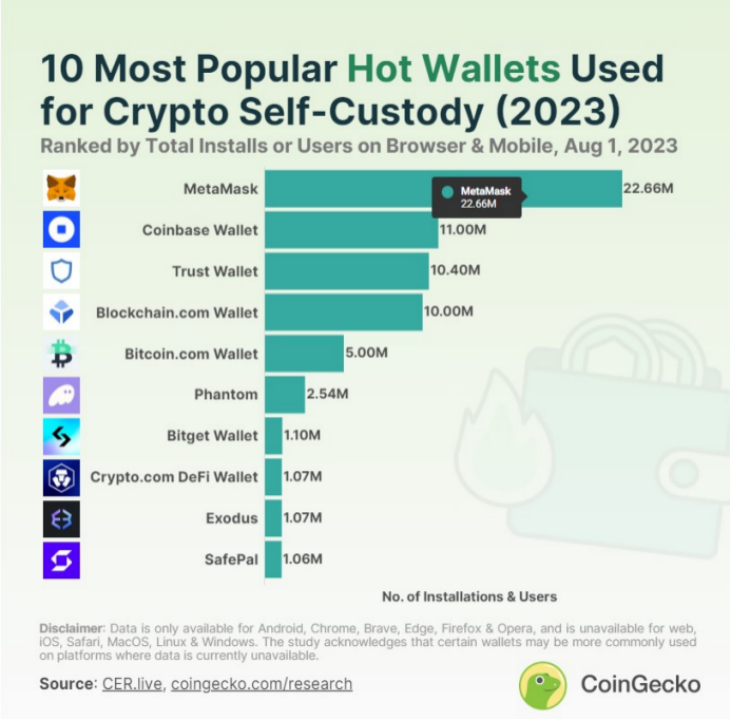
3.3.1 The launch of Sell has enabled the functionality of deposits and withdrawals.
On September 5, 2023, MetaMask launched its latest feature, "Sell," allowing users to exchange cryptocurrencies for fiat currencies through the MetaMask Portfolio and transfer funds to their bank accounts. For compliance reasons, this feature is currently available only in the US, UK, and certain parts of Europe, and only supports exchanges in USD, EUR, and GBP. MetaMask stated that initially, it will only support ETH on the Ethereum mainnet, with plans to expand to other native tokens on Layer2 networks in the near future.
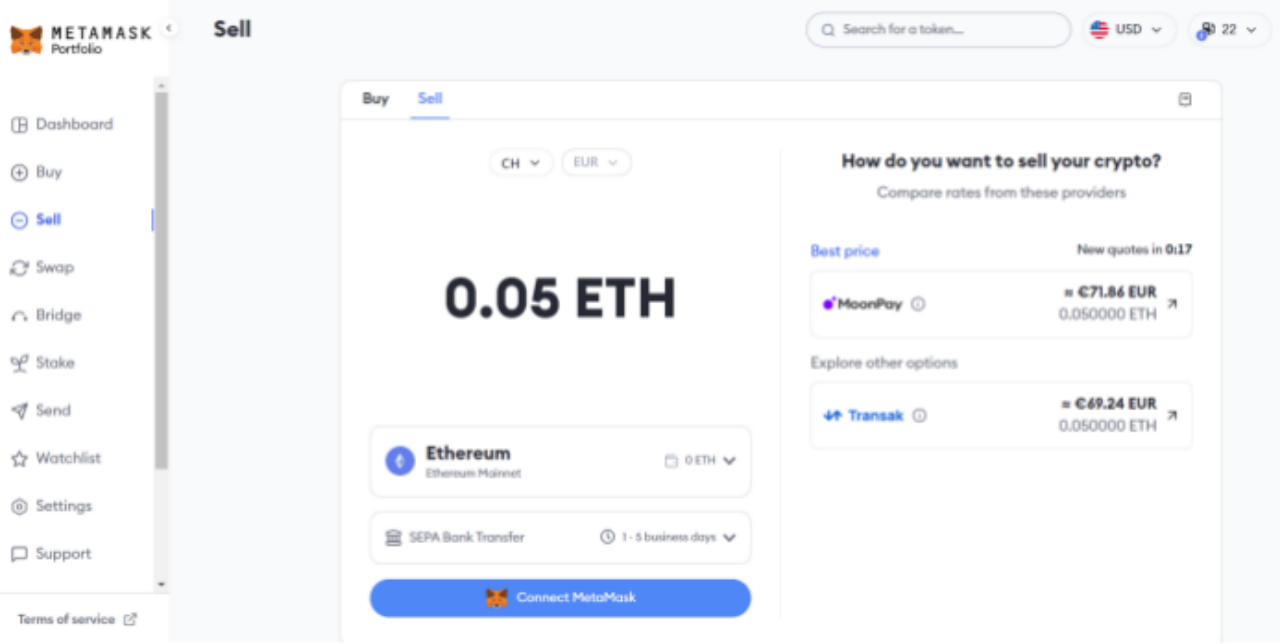
After selecting their region, users input the amount of ETH they wish to sell and choose a quote from multiple service providers, then link their bank account. According to official statements, MetaMask has partnered with cryptocurrency cash-out service providers such as MoonPay, Sardine, and Transak. However, currently, only MoonPay and Transak are offering this service, and it requires KYC verification.
The "Sell" withdrawal feature was launched five months after the "Buy" deposit feature went live on MetaMask. The deposit feature allows users to fund their accounts using bank accounts, PayPal, debit cards, and credit cards.
Non-custodial wallets like MetaMask, which are independently controlled by users (private keys) and interact directly with payment systems, only provide communication or network access services to support money transfer services, are not considered Money Services Businesses (MSBs) under FinCEN regulation. However, Moonpay, which provides payment channels for MetaMask, is considered an MSB.
3.3.2 Independent Third-Party Payment Company Moonpay
MoonPay is currently a leading project in cryptocurrency deposits and withdrawals, boasting over 5 million registered users. In terms of coverage, MoonPay supports crypto payments in more than 160 countries and regions, and facilitates the exchange of over 80 types of cryptocurrencies and more than 30 types of fiat currencies. As for payment methods, MoonPay currently accepts credit and debit cards, mobile payments, and account-to-account transfers among other channels. Uniswap has also previously integrated Moonpay as one of its deposit channels.
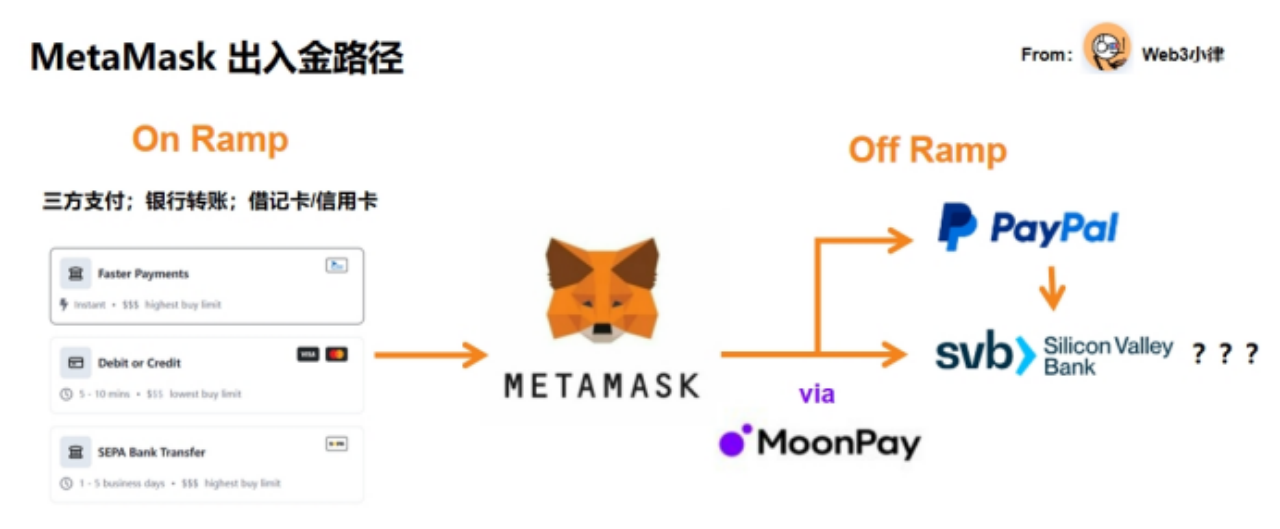
After integrating independent third-party payment companies like Moonpay, MetaMask has been able to establish a payment channel for deposits and withdrawals, a non-custodial wallet, and a variety of transaction functionalities (such as Swap, Bridge, Stake, etc.) on its portfolio page, essentially creating a logical closed loop.
3.3.3 Snaps version
On September 13, 2023, MetaMask released its Snaps version, which supports wallet integration for non-EVM (Ethereum Virtual Machine) chains including Solana, Sui, Aptos, Cosmos, and Starknet. Currently, there are 34 Snaps in the beta testing phase. In essence, MetaMask has made some of its functionalities open-source, allowing third-party developers to extend the MetaMask wallet in the way they desire, aiming to provide users with a more personalized or diverse trading experience.
In the past, when users wanted to interact with various public blockchains, they had to download the corresponding wallet plugins, which not only provided a poor user experience but also indirectly increased many security risks. Now, MetaMask has opened up a set of Snaps API access standards, allowing third-party public chain wallet providers to overcome technical challenges and integrate on their own. MetaMask is only responsible for the audit of the integration, while the rest of the development work is completed by third-party developers.
With this, users only need to download the MetaMask wallet and install third-party public chain plugins to achieve free movement across various public chain networks, with enhanced security. This is a very smart move in ecosystem integration, further solidifying its leading position in the plugin wallet market.
MetaMask's inherent advantage lies in its nearly 30 million monthly active users. In the foreseeable future, it's expected that MetaMask will evolve into a super wallet traffic portal, managing wallet traffic to distribute to various DApps. This opens up significant commercial possibilities.
IV. Regulatory Compliance in Web3 Payments
Due to the openness and innovation of cryptocurrency assets, it's challenging to uniformly define their attributes. Currently, most jurisdictions do not have a comprehensive regulatory framework specifically for cryptocurrency assets. **In practice, regulating Web3 payments not only requires compliance with cross-border payments and money transfer services but also with cryptocurrency business operations.** Furthermore, given the inherent global circulation of cryptocurrency assets, Web3 payments will face exceptionally complex compliance challenges across multiple legal jurisdictions worldwide. This also poses a significant challenge for regulators in each jurisdiction.
Despite this, we can still observe some jurisdictions actively exploring Web3 payments. For instance, crypto-friendly Switzerland has clearly defined "Payment Tokens"; similarly, Singapore also has a definition for "Payment Tokens" and recently released a regulatory framework for stablecoins; the European Union's MiCA legislation also clearly defines "E-Money Tokens".The continuous clarification of these regulatory definitions will grant cryptocurrencies a legitimate and effective status, thereby further propelling the development of the Web3 payment industry and leading the Web3 sector towards true mass adoption.
Compliance is the foundation upon which traditional giants stand, which is why we see them initially limiting their Web3 payment services to certain regions. For instance, MetaMask's Sell withdrawal service (supported by Moonpay) is currently only available in the US, UK, and parts of Europe, while Paypal's stablecoin is also limited to US users.Although projects can only engage in Web3 payment services in compliance with standards after meeting licensing, qualification, and permission requirements, this also represents a major barrier for participants in Web3 payment projects.
Due to the complexity of Web3 payments, which involve encrypted assets, payments, asset custody, stablecoins, anti-money laundering/counter-terrorism financing, and other legal compliance issues, the legal landscape is exceptionally intricate. The following will briefly outline the legal regulations concerning Web3 payments in major jurisdictions, to see how the giants are building legal compliance barriers.
4.1 United States
The primary regulatory body for Web3 payments in the United States is the Financial Crimes Enforcement Network (FinCEN), which operates under the U.S. Department of the Treasury. FinCEN is primarily responsible for overseeing and implementing work related to Anti-Money Laundering (AML), Counter-Terrorist Financing (CFT), and Know Your Customer (KYC) regulations. Additionally, it is tasked with collecting and analyzing financial transaction information, tracking suspicious individuals and activities through the study of mandatory disclosures by financial institutions.
FinCEN's authority is derived from the United States' Bank Secrecy Act (BSA), which treats cryptocurrencies as "currency". In 2019, FinCEN issued guidelines (Application of FinCEN’s Regulations to Certain Business Models Involving Convertible Virtual Currencies), establishing regulations related to crypto asset payments.
The 2019 Guide defines "money transmission" as the act of receiving currency (or the value of other monetary substitutes) from one party and sending all or part of it to another party. In this definition, "monetary substitutes" include money orders, stored value cards, and cryptocurrencies. In most cases, any "company" engaged in the business of money transmission will meet the definition of a "Money Service Business" (MSB) under the BSA, and will need to comply with BSA and FinCEN regulations, fulfilling compliance obligations.
A general summary of the 2019 guidelines for determining whether it is an MSB:
Whether the user's assets (private keys) are controlledCentralized exchanges and custodial wallet providers that serve U.S. customers, by virtue of being able to control user assets (private keys), are classified as Money Services Businesses (MSBs). Conversely, non-custodial wallets like MetaMask, as well as Decentralized Exchanges (DEXs) that only facilitate matchmaking transactions, where users independently control their assets (private keys) and interact directly with the payment system, or those that merely provide communication or network access services to support money transmission services, are not considered MSBs.
The monetary transfer nature of the businessPayment companies that provide services to users in the United States, such as Moonpay, Paypal, Stripe, Square, are engaged in the business of money transmission and are classified as MSBs (Money Services Businesses).
Companies classified as MSBs not only need to comply with BSA and FinCEN regulations and fulfill compliance obligations but also need to obtain Money Transmitter Licenses (MTL) in accordance with state money transmission laws. While obtaining an MSB license in the United States is relatively easy, applying for an MTL license can be time-consuming, requiring about two years and millions of dollars in legal consulting fees to secure an MTL license in various states.
The BitLicense is a cryptocurrency license created by the New York State Department of Financial Services under the New York Financial Services Law. It is designed to regulate crypto asset institutions and related trust companies (a New York State limited purpose trust company) within the state. Licensees must comply with the BitLicense regulatory framework, which includes consumer protection, anti-money laundering compliance, and cybersecurity guidelines. Previous recipients of the BitLicense include XRP II, Circle Internet Financial, Gemini Trust Company, itBit Trust Company, and others.

This is also why we see in the news that X (formerly Twitter) is actively applying for Money Transmitter Licenses (MTL) in various states in the U.S. For X (formerly Twitter) to emulate WeChat, it inevitably requires a payment system similar to WeChat's. And for payment companies that have already obtained licenses in various states, this will be their core barrier to operating Web3 payment businesses in the U.S.
4.2 United Kingdom
Companies looking to launch Web3 payment services in the UK must obtain an E-Money Institution (EMI) license issued by the Financial Conduct Authority (FCA). We've seen entities like Coinbase securing an EMI license as early as 2018, allowing them to expand their cryptocurrency operations within the EU.
Interestingly, Aave, a decentralized lending platform based in London, also obtained an EMI license in 2020. It is reported that this move is a compliance measure taken by Aave to attract more users into DeFi, possibly also due to the strict consumer protection compliance requirements in the UK.
Before Brexit, holders of the UK EMI license were unrestricted by time or field of activity within the European Economic Area (EEA), allowing them to offer any form of service. After Brexit, more companies shifted their focus towards the more neutral and friendly Ireland.
4.3 Ireland/European Union
In 2021, Ireland introduced a registration system for Virtual Asset Service Providers (VASP), overseen by the Central Bank of Ireland, to ensure companies meet the requirements for Anti-Money Laundering (AML) and Counter-Terrorism Financing (CTF). Following Coinbase's acquisition of an EMI license authorized by the Central Bank of Ireland, Coinbase Ireland Limited obtained the VASP license in 2022. This license allows Coinbase to issue electronic money, provide electronic payment services, and process electronic payments for third parties.
Similarly, after obtaining the EMI license in the UK, Moonpay was registered as a VASP by the Central Bank of Ireland in 2023. Its CEO stated, "We believe that registering as a VASP in Ireland first, and eventually applying for registration under the EU's MiCA, will provide a significant competitive advantage for the company to enter the EU market compliantly."
The European Union's "Markets in Crypto-Assets Regulation" (MiCA) has been passed by the European Parliament and is expected to come into effect in 2024. Broadly speaking, MiCA applies to all entities involved in the issuance of crypto-assets, as well as those providing related services within the EU: (1) issuers of various types of crypto-assets, including E-Money Tokens, Asset-Referenced Tokens, and other Tokens; (2) various crypto-asset services and service providers, including wallet custody services, deposit and withdrawal services, exchange services, asset management services, investment advisory services, etc.
MiCA fills the gaps in the current EU financial regulatory framework. Once implemented, it will create a unified crypto asset regulatory framework within the EU, directly forming a large crypto asset market that spans 27 countries and affects 450 million EU citizens. Since obtaining a VASP license in one EU member state allows for business operations across the entire EU region, regions with the most lenient cryptocurrency regulations in the EU, like Lithuania, have become the preferred registration destinations for many centralized exchanges and payment institutions.
4.4 Hong Kong
With the passage of the Hong Kong VASP system, all centralized crypto asset exchanges operating in Hong Kong or actively promoting their services to Hong Kong investors, regardless of whether they offer security token trading services, will need to be licensed by the Hong Kong Securities and Futures Commission and be subject to its regulation.
At the same time, the VASP system requires centralized exchanges to "safely custody client assets," meaning that platform operators must hold client funds and crypto assets in trust (TCSP trust license) through a wholly-owned subsidiary. This implies the need for a TCSP license to independently custody investors' assets, to prevent cases of self-dealing.
The full name of TCSP license is Trust or Company Service Providers. Since traditional banks can only hold legal tender assets, the custody of crypto assets can currently only be placed under trust accounts. This also grants the TCSP trust license a new business scenario.
The Hong Kong High Court has previously made a determination in the case of Re Gatecoin Ltd [2023] HKCFI 914 that crypto assets are considered "property" and explicitly stated that they "can be held in trust". Therefore, any company engaged in the custody of crypto assets must apply for a TCSP license. Exchanges such as OSL, Hashkey Group, and Gate.io all have their own TCSP trust companies. Additionally, the wallet infrastructure and digital asset custody service provider Liminal has also recently obtained a TCSP license.
According to the Anti-Money Laundering Ordinance, any entity operating or intending to operate a money service in Hong Kong must apply for a Monetary Service Operator (MSO) license from the Hong Kong Customs. For Web3 payment services, if a company's related crypto business in Hong Kong includes currency exchange services or remittance services, the service provider needs to obtain an MSO license issued by the Hong Kong Customs.
4.5 Singapore
The Monetary Authority of Singapore (MAS) serves as Singapore's central bank and comprehensive financial regulatory body, also overseeing the Web3 industry. According to the "A Guide to Digital Token Offerings" published by MAS in May 2020, security tokens and payment tokens are regulated under two specific legislations, while utility tokens are not regulated.
For payment tokens, according to the Payment Services Act that came into effect in January 2020, providing Digital Payment Token (DPT) services in Singapore, including direct transaction services for DPTs (such as buying, selling, fiat currency exchange, and coin-to-coin exchange) as well as services that facilitate DPT transactions (such as exchanges, custodial institutions, wallet services, etc.).
The difficulty of applying for this license is relatively high, and in recent years, there has been a particularly cautious attitude towards the crypto sector. However, Singapore offers an indefinite exemption period for the operation rights of DPTs, allowing operations to commence without a license. In 2022, institutions such as Circle, Paxos, Blockchain.com, Coinbase, Luno, Digital Treasures Center, Crypto.com, and Genesis were successively granted DPT licenses.
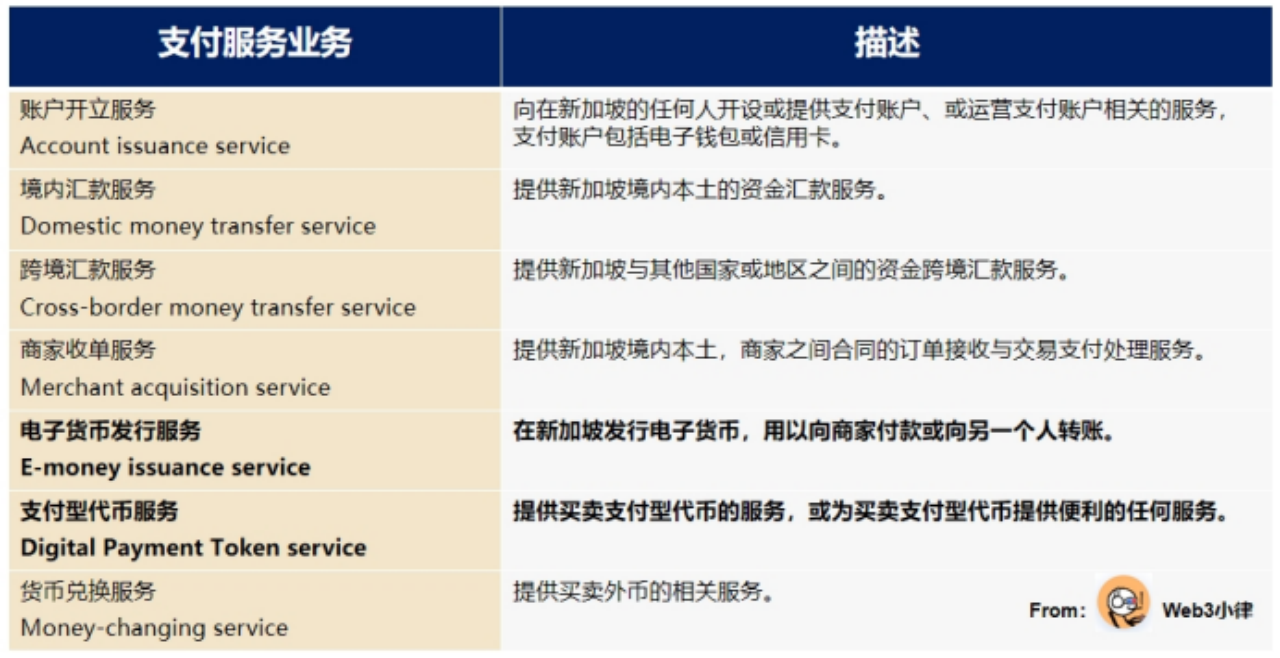
V. The Future of Web3 Payments
From a market perspective, this remains a highly desirable blue ocean market. **According to statistics, there are currently 1.7 billion people worldwide without bank accounts, yet in dire need of financial services.** Countries with high inflation, a majority of the population lacking banking services or with insufficient banking services, or where the traditional financial system is deemed unreliable, have witnessed a surge in crypto payments due to these innovations. The sheer number of over 420 million cryptocurrency owners globally is enough to demonstrate that the cryptocurrency industry is far from speculative; it is a thriving and rapidly growing sector.
From the perspective of innovative development, the current efforts to meet the growing demand for cryptocurrencies involve continuous innovation and optimization of Layer 2 scalability solutions, stablecoins addressing the volatility of cryptocurrencies, compliance asset management solutions by wallet service providers and custodial institutions to ensure asset security, and payment solutions for deposits and withdrawals by Web3 payment companies to tackle merchant receivables and mobile payment issues. These burgeoning technological innovations lay a solid foundation for Web3's march towards mass adoption.
Looking back at the implementation paths of Web3 payments by giants such as PayPal, Coinbase, MetaMask, as well as their strong traffic and scenario entry points, and then imagine the exclusive advantages of players who are going all out, such as X (formerly Twitter) and Telegram.It's not hard to see that after the giants integrate basic functions such as wallets, custody, stablecoins, and payments, they will each form their own vast Web3 crypto ecosystems. In this context, the current crypto market landscape, which is primarily exchange-driven, is bound to change.
Beyond the vast Web3 crypto ecosystems developed by the giants, the interoperability of Web3 products with external systems is also a transformative aspect. Take Web3 wallets as an example; these wallets are tools closely integrated with the DApp ecosystem, providing direct access and functionality for using DApps. Currently, OKX Web3 wallet users can access over 5,500 DApps, and the wallet has already integrated more than 500 DApps. Not to mention, MetaMask boasts nearly 30 million monthly active users, and the MetaMask Portfolio DApp has aggregated functions such as Sell, Buy, Stake, Dashboard, Bridge, and Swap.
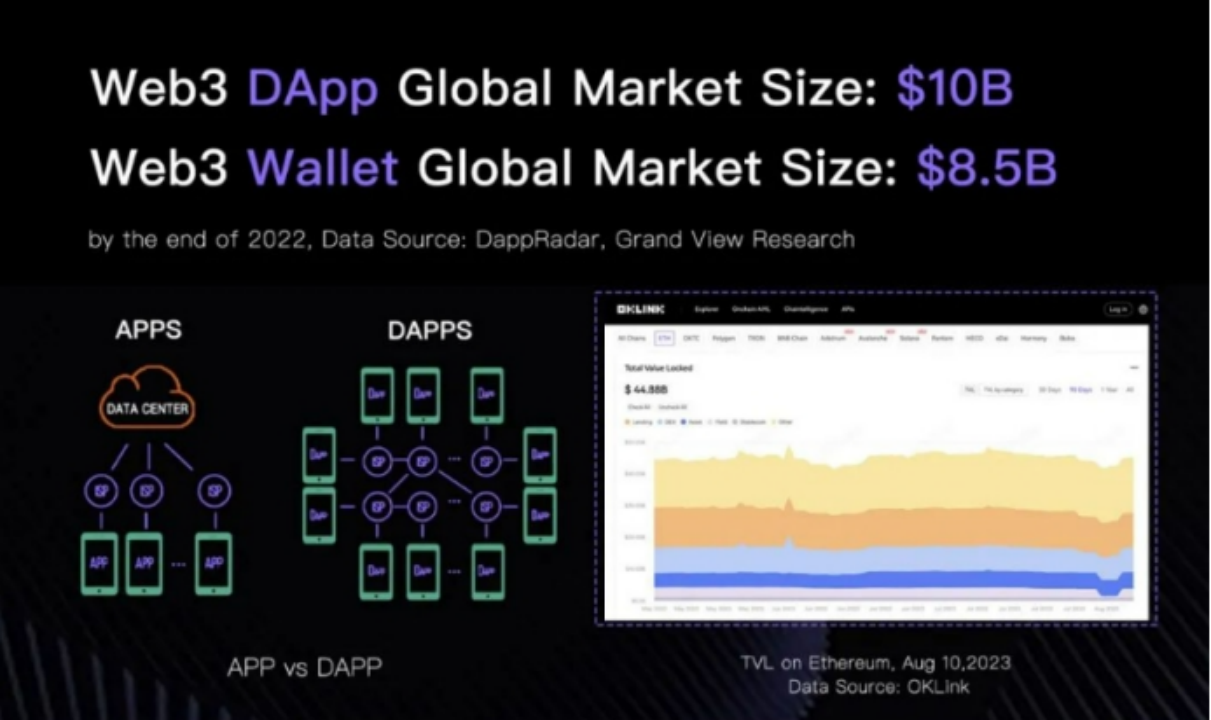
From the perspective of the monetary system, the Bank for International Settlements (BIS) stated in the "Blueprint for the Future Monetary System" that the current monetary system is on the verge of another significant leap.In the era following digitalization, the key to the evolution of the monetary system is tokenization - the process of digitally representing claims on a programmable platform, which can be seen as the next logical step in digital record-keeping and asset transfer.
The future monetary system will leverage tokenization to improve upon the old monetary system and support the new one. By utilizing a new intermediary method (a unified ledger) to serve end-users, it eliminates the manual intervention and reconciliation caused by the separation of traditional message transmission, clearing, and settlement, thereby removing delays and uncertainties.Tokenization can significantly enhance the capabilities of the monetary and financial systems. The future monetary system is expected to unleash new economic growth dynamics through tokenization, which is impractical in the inherent frictions of the current monetary system.
This type of tokenization is not only about the recently popular Real World Asset (RWA) tokenization but also includes the tokenization of currency itself. Tokens not only define assets but also, through their programmability, incorporate the payment logic into the tokens, thereby defining what the assets can be used for.
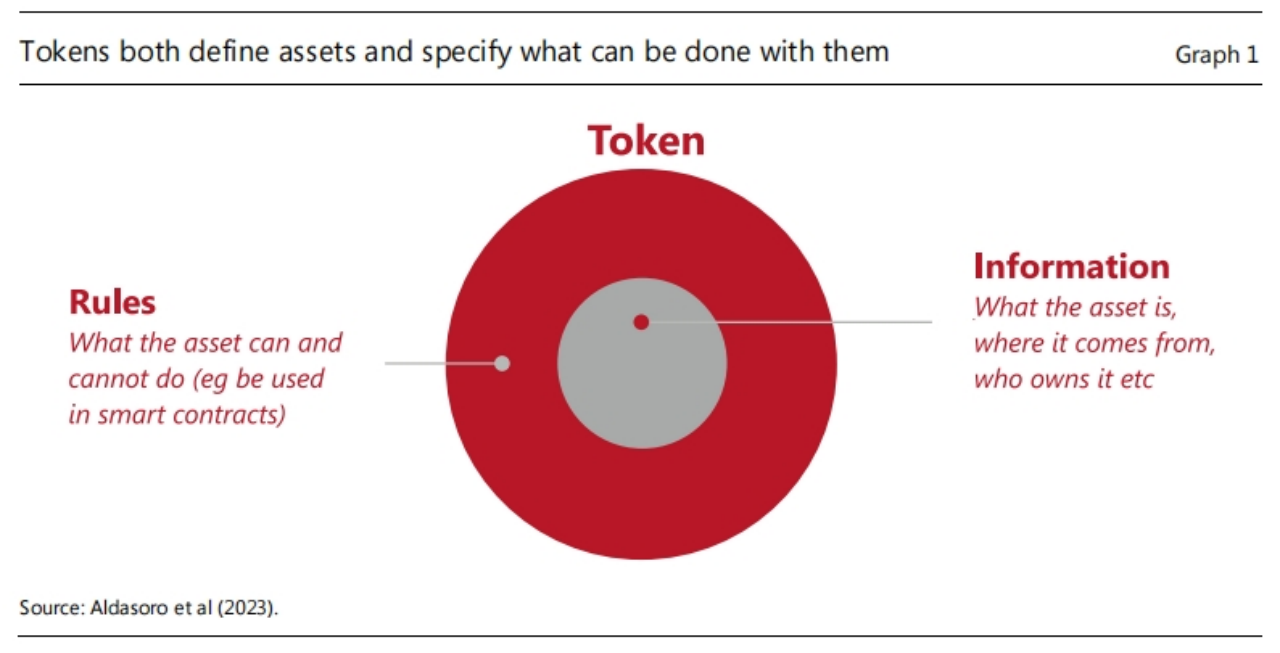
VI. In Conclusion
Without a doubt, in the near future, Web3 payments will become commonplace, potentially completely replacing existing payment methods, whether within businesses or between individuals. At the same time, traditional finance will also connect finance and trade through Web3 payments, making the expression, circulation, trading, programming, and regulation of assets the main value proposition, highlighting efficiency advantages.
The greatest opportunity for cryptocurrencies may not lie in viewing them as cryptocurrencies, but in seeing them as a new payment method. Some believe that the killer application for Web3 has yet to arrive, but it might have already quietly made its entrance: it's payments!
Digitization and tokenization will endow the traditional monetary system with new value, overcoming previously insurmountable boundaries. This could forever change the global economy.
REFERENCE
- ZONFF Research, panoramic interpretation and trend analysis of the Web3 payment track
- Blueprint for the future monetary system: improving the old, enabling the new
- Bing Ventures, Crypto Payments Market Size To Reach Hundreds Of Billion Dollars In Three Years
- TokenInsight, 2021 Digital Assets Payment Industry Research Report
- Ripple & FPC, Blockchain & Crypto in Payments: Transforming the Way Money Moves
- B2BinPAY, How Crypto Payment Solutions Have Changed the Market
- Sygnum Bank, 加密货币作为支付手段:一个不断发展的大趋势
- Celine Wee, On/off Ramps in Web3: an Introductory Guide
- PAYPAL CRYPTOCURRENCY TERMS AND CONDITIONS
- LD Capital: Exploring Coinbase's Investment Logic and Growth Potential
- Ouke Cloud Chain, technology giants are betting heavily, can Web3 wallets become the fulcrum to leverage the industry?
- Visa, Crypto stablecoin settlement
- FinCEN法规对某些涉及可转换虚拟货币的商业模式的应用
- Meng Yan's Reflections on Blockchain: A Decade of Reevaluation in the 'Chain Circle'
- CSDN, [Payment Architecture] Cross-border Payments
- TouBao Research Institute, Ren Jingyi, Cross-border Payments

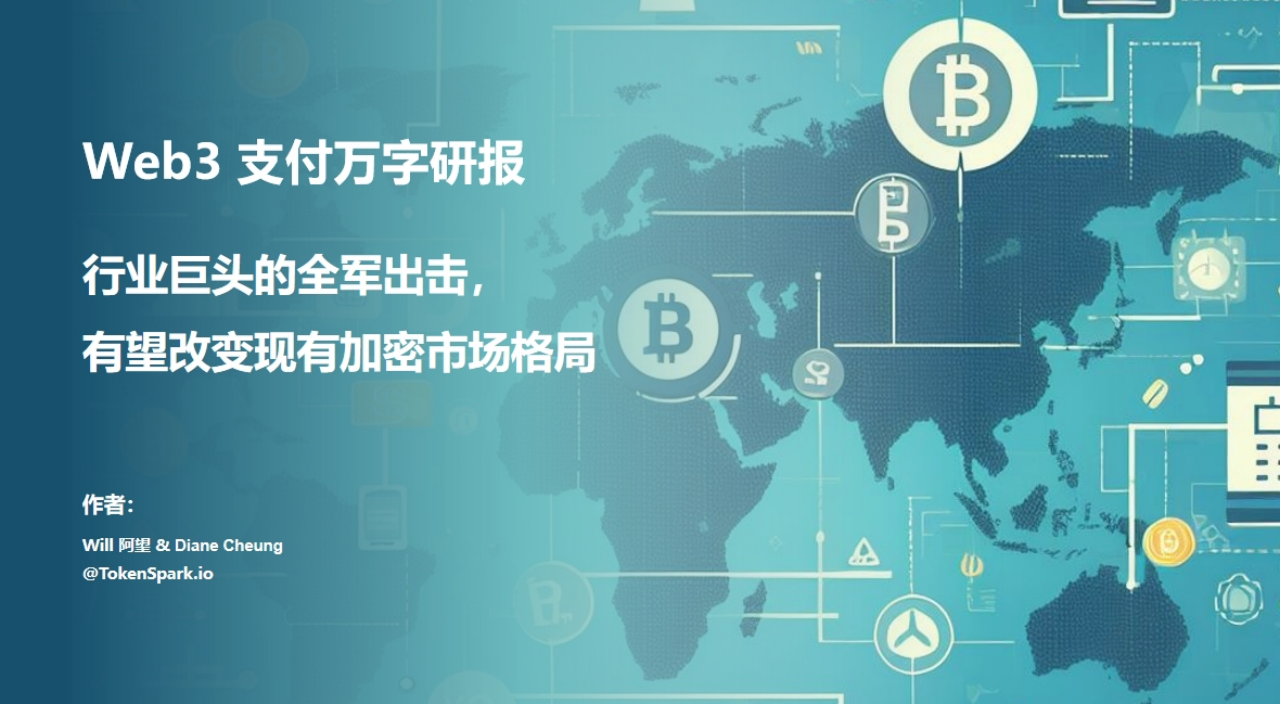
The emergence of blockchain and cryptocurrency technologies not only enables people to purchase NFT digital artworks, interact with players in the Metaverse, and earn money through GameFi gameplay, but it also offers the most fundamental decentralized peer-to-peer payment solutions. These fast, convenient Web3 payment solutions are changing the way we make payments today, and even the entire financial market.
Since PayPal launched its stablecoin, PayPal USD, in August 2023, we've observed numerous industry giants officially announcing their expansion into Web3 payments or integrating Web3 payment channels. It seems like a full-scale deployment into the Web3 payment sector is underway. We can see MetaMask collaborating with Mastercard to launch a fully blockchain-based payment card; X is applying for a payment license intending to incorporate Dogecoin into its payment system (rumored); and the VISA USDC settlement blockchain payment network, among other significant moves by industry leaders.
Given that Web3 payments encompass nearly all the infrastructure in the industry, including payments, stablecoins, wallets, custody, trading, etc., it's crucial for all participants in the Web3 ecosystem to understand the wide range of use cases and potential advantages of Web3 payments.
This article will briefly outline the concept and path of Web3 payments, and then, from the perspectives of business and legal compliance, discuss why Web3 payments are expected to reshape the crypto market landscape. It is hoped that this article can be of assistance in this regard, and discussions are welcome.
Traditional payment systems and Web3 payments are not isolated from each other; instead, they are moving towards each other. Fiat currencies and cryptocurrencies are continuously interacting and gradually merging into stablecoins, central bank digital currencies (CBDCs), and other practical use cases.
Bitcoin was designed to facilitate a decentralized peer-to-peer electronic cash payment system, from which Web3 payments evolved. Currently, Web3 payments can be broadly categorized into two types: fiat currency transactions, and cryptocurrency payments (on-chain, off-chain);
Industry giants such as PayPal, Coinbase, MetaMask, Visa, and Mastercard are gradually opening up/accessing Web3 payment services and scenarios, including wallets, custody, payments, transactions, and stablecoins, eventually covering their entire ecosystem to form their own closed-loop ecosystems;
The infrastructure for Web3 payments is gradually taking shape, involving linking wallets, custody, and stablecoins. However, what's more crucial is how to construct payment scenarios. Imagine how X (Twitter), Telegram, MetaMask, and PayPal will each develop their vast crypto ecosystems. In such a context, the existing landscape of the crypto market is bound to change;
Compliance is the foundation of the payment industry. The cross-regional and cross-scenario complexity of Web3 payment services poses significant challenges to regulatory compliance. However, as cryptocurrency regulation becomes clearer, it is expected to further increase the adoption of cryptocurrencies and promote the rapid development of the Web3 payment industry.
From the perspective of the monetary system, the Bank for International Settlements (BIS) believes that the key to the development of currency after digitalization is tokenization. Tokenization can significantly enhance the capabilities of the monetary and financial systems, and the future monetary system is expected to unleash new economic growth momentum through tokenization.
The greatest opportunity for cryptocurrencies may not lie in viewing them as cryptocurrencies, but in seeing them as a new payment method. Some believe that the killer application for Web3 has yet to arrive, but it might have already quietly made its entrance: it's payments!
1. Overview of Web3 Payments
In simple terms, Web3 payments refer to a payment method based on blockchain and cryptocurrency technologies. However, due to the unique characteristics of blockchain and cryptocurrencies, Web3 payments encompass more than just the payment aspect.
Cryptocurrencies like Bitcoin have multidimensional attributes.It is not only a form of payment but also an innovative technology, a means of storing value, and a financial infrastructure in the form of a distributed ledger. Additionally, it can serve as a unit of account in transactions, marking value.
Traditional payment systems and Web3 payments are not isolated from each other; instead, they are moving towards each other in a bidirectional manner. Fiat currencies and cryptocurrencies are continuously interacting and gradually merging into practical applications such as stablecoins and central bank digital currencies (CBDCs). Web3 payments are redefining our methods of payment and the financial system as a whole.
1.1 Traditional Payment
Let's first look at traditional payment methods. Payment is the act of transferring currency (or its equivalent) or credit from the payer to the payee. It is a process where the flow of information and funds are matched to complete the delivery of money and goods.The essence of payment is the transfer of funds.
Broadly speaking, payment methods include both cash and electronic money. There are generally four ways to transfer funds: cash payments; bank account transfers; debit card transfers; and credit card payments. Among these, the last three, which are forms of electronic money, require a centralized financial system like a bank to complete the transfer of funds. If the bank is unable to directly complete the payment, the involvement of a third-party payment institution is necessary.
Based on the currency used for payment, transactions can be categorized into domestic and cross-border payments. Given that Web3 payments are conducted on the blockchain, enabling transactions across different currencies (fiat vs. cryptocurrency) and regions, they can be considered a form of cross-border payment.
The cross-border payment industry chain involves numerous participants, including customers, commercial banks, third-party account/sales end payment institutions, clearing institutions, merchants, and more. The entire industry chain can essentially be divided into three levels: The first level consists of users and merchants, who are the source and terminal of payments, respectively; the second level comprises payment service institutions, such as banks and third-party payments; the third level is the cross-border payment network, which is the foundational support for cross-border payments, such as SWIFT and SEPA, among others.
The diagram below illustrates the architecture of cross-border payments:
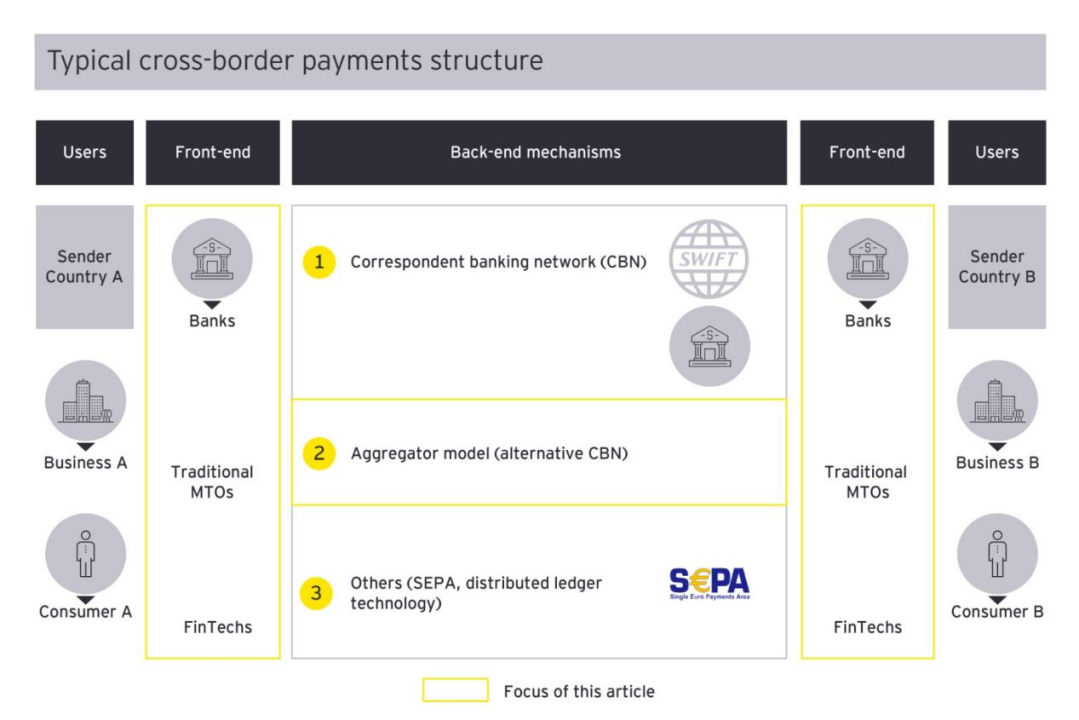
Based on the type of cross-border payment service providers, they can be categorized into bank wire transfers, specialized remittance companies, card-based payment clearing institutions, and third-party payment organizations. The following examples will compare these with Web3 payments that are settled using blockchain technology.
1.1.1 Cross-border payments between banks
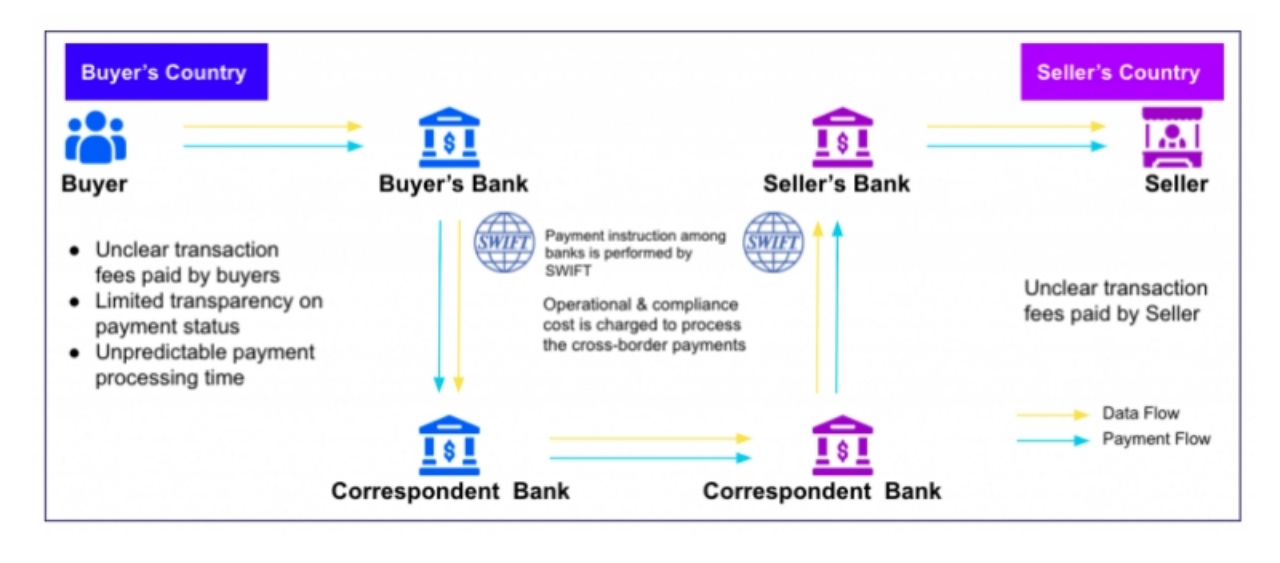
In the early days, cross-border payments were primarily conducted through banks, such as the earliest appearance of bank wire transfers, which were mainly used for inter-bank transactions, import and export trade, and other cross-border payments. This method of payment required navigating through a complex network of banks and could take several days or even weeks to complete. The process might involve the exchange of multiple currencies, and the fees were relatively high.
Traditional cross-border payments through banks primarily rely on the SWIFT network. SWIFT does not hold funds or manage accounts for users but provides a communication information network and exchanges standardized financial messages. SWIFT can be seen as a network that connects nearly all mainstream banks globally, allowing them to complete foreign exchange transactions using a common language. However, SWIFT has its drawbacks. A transaction can easily experience delays or even fail if it goes through multiple intermediary banks or encounters anti-money laundering checks. Additionally, there are issues like exchange losses.
As illustrated above, when a commercial account relationship is established between the receiving bank and the paying bank, the payment made by the user is directly transferred through the bank's commercial account, with the bank charging a corresponding fee. However, when there is no commercial account relationship between the receiving bank and the paying bank, an intermediary bank is required to complete the transaction. The intermediary bank will charge additional fees, and the payment arrival time will also be extended due to the increase in transaction parties.
Cross-border payments in banking are subject to strict regulation, with varying policies across different countries and regions, which imposes certain limitations on cross-border payments. Additionally, most cross-border payments through banks come with stringent KYC/AML requirements, necessitating the opening of an account before completion, thus making it relatively costly.
1.1.2 International Card Organizations
Similar to SWIFT, international card organizations also serve as a major network for traditional cross-border payments, but they focus more on the merchant acquiring scenario (where merchants charge buyers' accounts). These acquiring methods are diverse, and the currency exchange process is directly completed during the payment process, settling in the local currency for merchants.
Card organizations are international regional payment information processing networks, currently comprising six major global networks: VISA, Mastercard, China UnionPay, American Express, JCB, and Discover. Cross-border payments processed by international card organizations typically require T+1 day or longer to complete, meaning they take at least T+1 day to reach the merchant's account. The operation of payments through international card organizations also requires a license and is subject to the regulatory policies of different countries.
1.1.3 Third-Party Cross-Border Payments
With the development of e-commerce and internet technology, electronic transfers have become a popular method for cross-border payments. This type of cross-border payment is generally provided by non-bank institutions (such as Alipay, PayPal, etc.) as third-party payment providers offering full or partial fund transfer services. These third-party payment institutions play a significant role in cross-border e-commerce retail, remittances, import and export business, and overseas mobile payments.
Third-party cross-border payments require integration with international card organizations or banks for clearing and settlement to complete the payment. The currency exchange process in cross-border payments is mainly carried out by banks. Third-party payment platforms often have a custodial function, meaning the funds can be deposited in the third-party payment account and transferred to the seller's account once the transaction is confirmed.
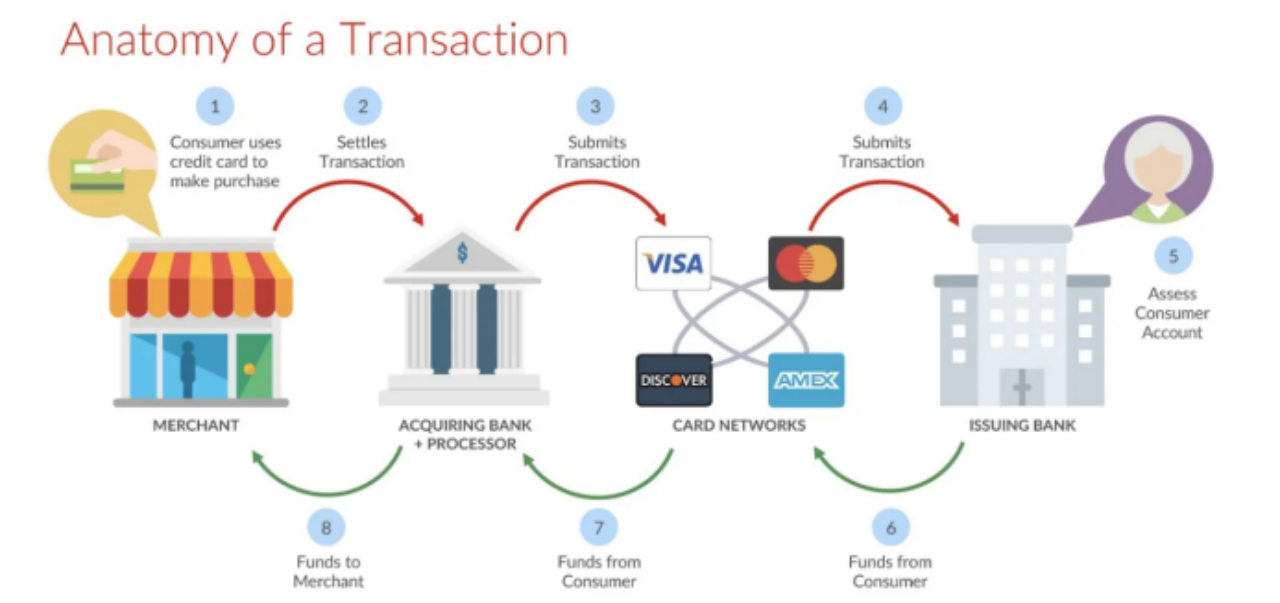
As shown in the diagram, in a cross-border e-commerce scenario, the user side is the starting point of the fund transfer. The third-party payment institution connects the user's bank account with the issuing bank's credit/debit card. After the user makes a purchase, the funds are transferred to the payment channel and connected with the card organization for clearing and settlement. After clearing and settlement, the third-party payment institution transfers the funds to the merchant. When there is an offline shopping scenario, there needs to be an acquiring agent to connect the merchant with the third-party payment institution.
Traditional payment systems have been around for a long time and currently cover most application scenarios with a wide range of functionalities. However, cross-border payments face significant challenges such as high costs, slow speeds, limited access, and a lack of transparency. According to a survey by the Federal Reserve, users' main pain points are centered around two aspects. First, there is a need for faster payment speeds as the current processing times do not meet user expectations, with a desire for 24/7/365 payment services. Second, there is a strong demand for periodic real-time payment scenarios.
1.2 Web3 Payments
Although the current payment methods are rapidly digitizing, the process of transferring funds is very cumbersome due to the large number of participants, and the friction costs are also very significant, resulting in high costs.The improvement of payment experience has always been constrained by various parties, including intermediary agencies, banks, and technology companies.
Bitcoin was designed from the outset to be a decentralized peer-to-peer electronic cash payment system. In 2008, against the backdrop of the global financial crisis, Satoshi Nakamoto published the Bitcoin whitepaper, aspiring to transform the traditional bank-centered financial system and achieve complete financial decentralization. Since its inception on January 9, 2009, Bitcoin has ushered in the era of widespread cryptocurrency adoption.
Bitcoin payments enable direct transfers between users without the need for third-party institutions such as banks, clearing centers, and electronic payment platforms, thereby avoiding high fees and cumbersome transfer processes. Any user with a device connected to the internet can use it without permission.
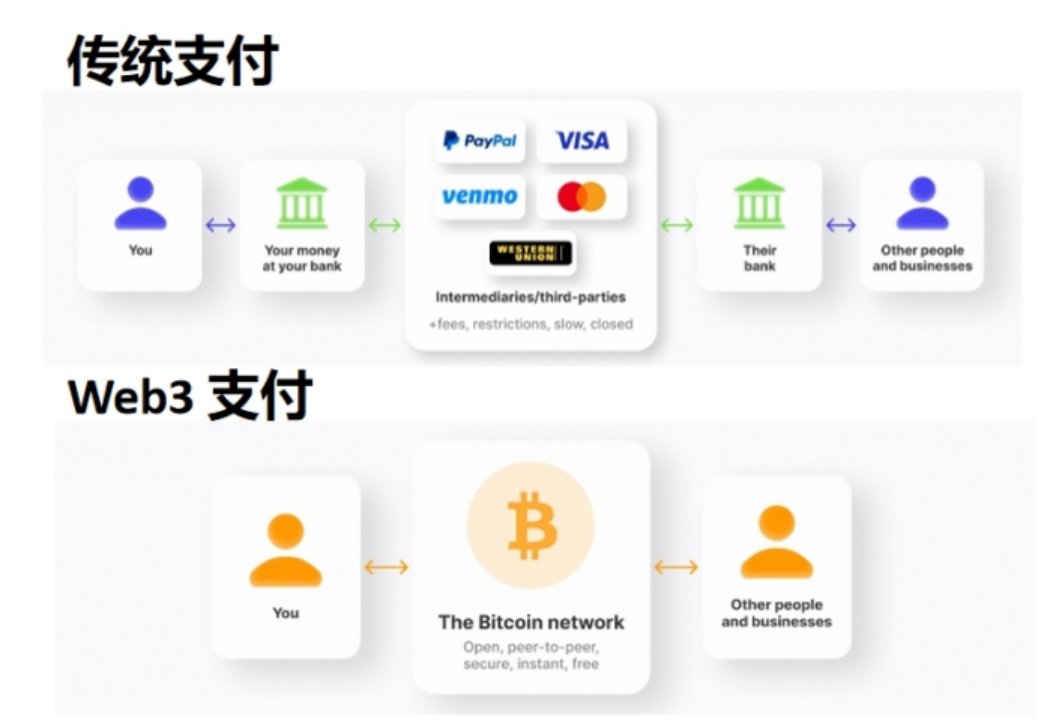
Similar to the Bitcoin payment network, cryptocurrency payments rely on the blockchain network as the backbone infrastructure, allowing cryptocurrencies to be transferred directly between the sender and receiver without any third party, quickly, conveniently, and at a very low cost.
As the acceptance of cryptocurrencies continues to rise, the inevitable interaction between cryptocurrencies and the real-world fiat currencies occurs. In this context, institutions that offer deposit and withdrawal services act as banks in cross-border payments, facilitating the exchange between cryptocurrencies and fiat currencies.
From this, currentlyWeb3 payments can primarily be divided into two types: (1) On-ramp and Off-ramp payments.payments in the context of cryptocurrency and fiat currency exchange;(2) Cryptocurrency payments, including (2.1) native asset payments on the cryptocurrency blockchainIn the realm of blockchain, interactions between two addresses or between cryptocurrencies and on-chain assets (such as purchasing NFTs with cryptocurrencies, or swapping between different cryptocurrencies);And (2.2) traditional physical payment off the cryptocurrency chainThis refers to its role as a medium of exchange when purchasing other goods/services;
Web3 payments connect fiat currencies with cryptocurrencies through deposit and withdrawal payments, allowing the circulation of crypto assets through cryptocurrency payments, thus forming a complete payment loop.
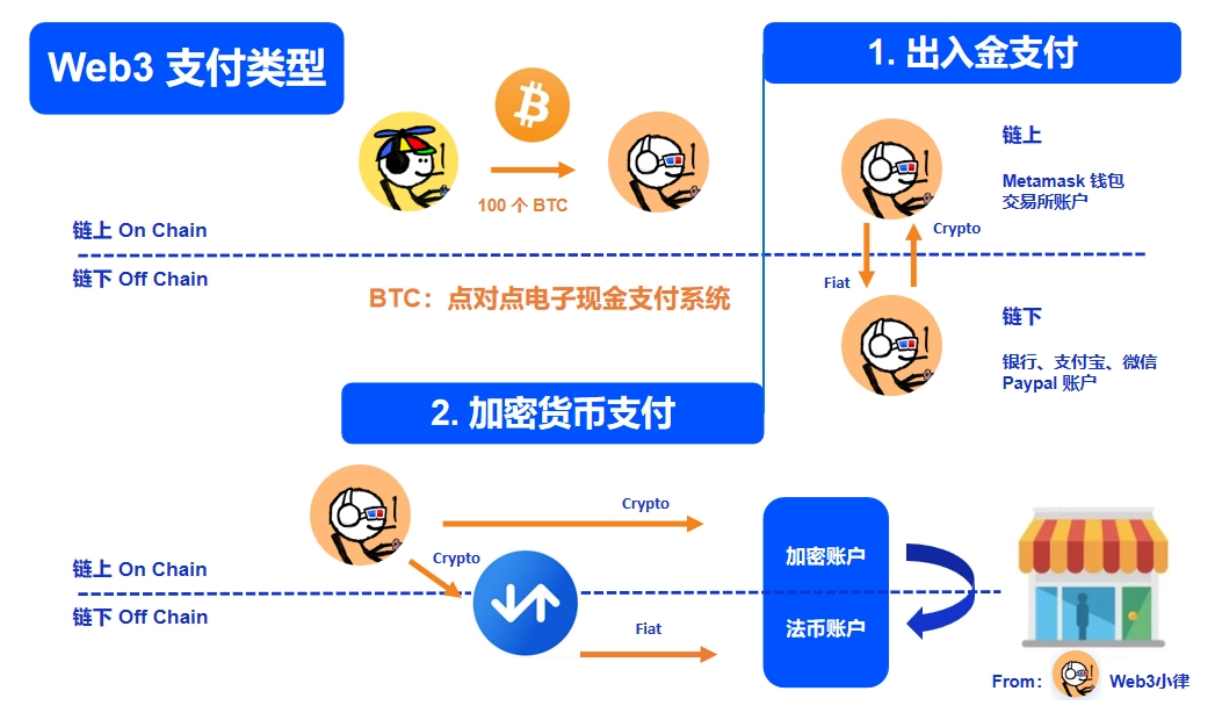
Since cryptocurrency payments are conducted on the blockchain, they are essentially not limited by geography. Regulatory frameworks in various jurisdictions are gradually being improved to accommodate this. However, the process of depositing and withdrawing funds involves fiat currency transactions, and thus, it is subject to existing financial regulations.
1.3 Advantages of Web3 Payments Over Traditional Payments
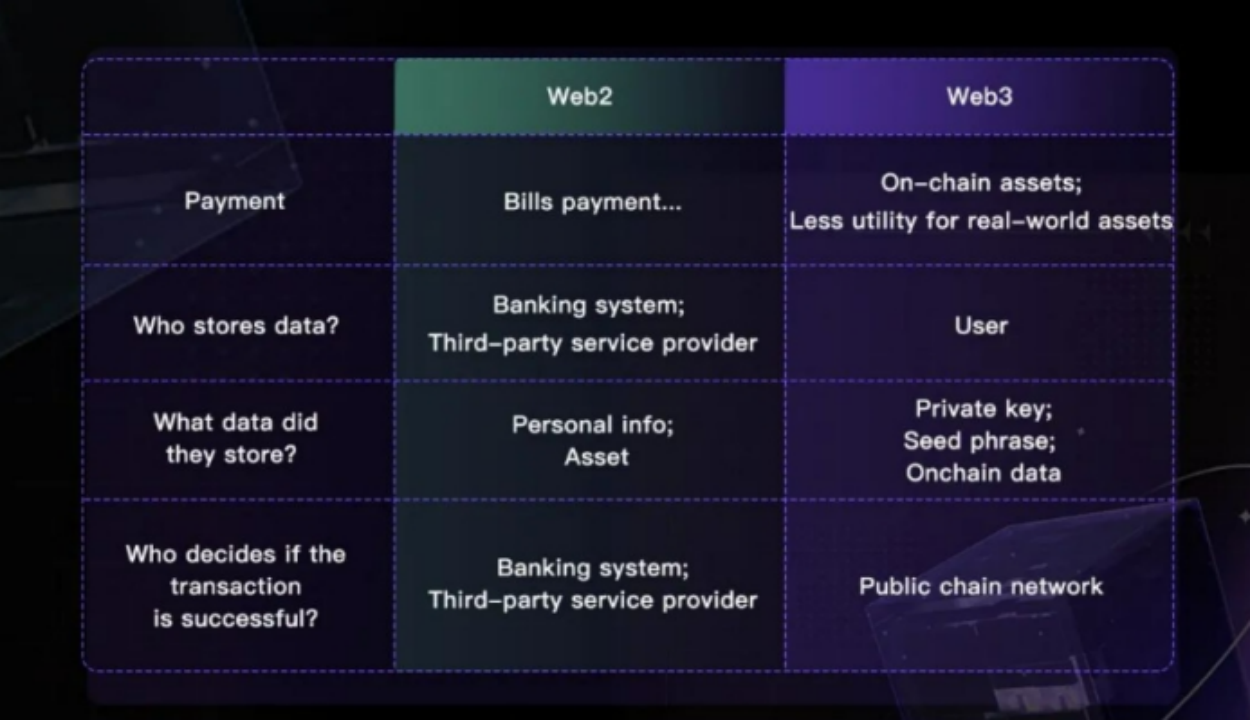
Traditional payment is a system based on account systems, where the transfer of value is recorded in the accounts of intermediary institutions (such as banks, third-party payment companies). Due to the involvement of numerous participants, the process of fund transfer is very cumbersome, and the frictional costs are also very significant, resulting in high costs.
In comparison,Web3 payments represent a payment system based on a value-based or token-based system, where the transfer of value is stored in the distributed ledger on the blockchain by the users themselves. Web3 payments rely on blockchain networks as their core infrastructure, allowing for the transfer of cryptocurrencies between the sender and receiver. This system can address issues in traditional payments such as high fees, low efficiency in cross-border transfers, and high costs.
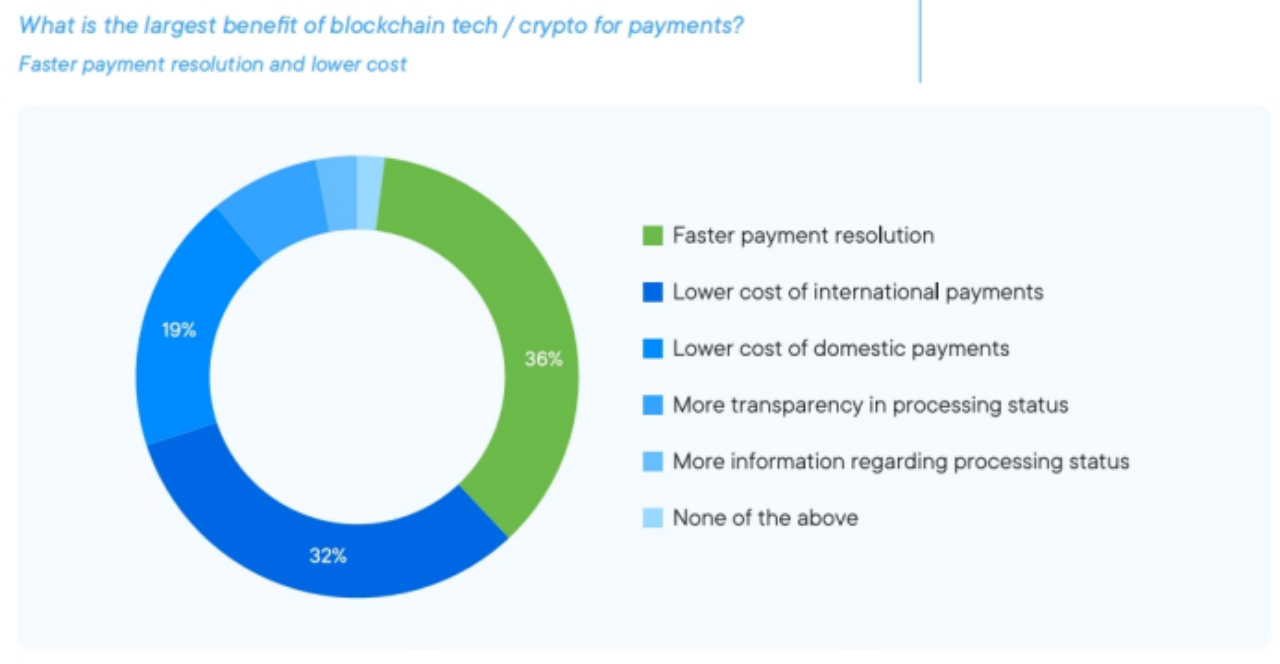
Compared to traditional payment methods, what are the advantages of Web3 payments?
Firstly, relying on blockchain technology can effectively reduce the cost of trust between trading parties, making payments more direct, faster, and safer. The functionality of smart contracts enables programmable payments and automated execution, enhancing the efficiency and credibility of payments.
Secondly, the timeliness of cryptocurrency payments currently has a significant advantage over traditional payments, especially in the realm of cross-border payments. This characteristic is likely to be a key driver in the development of cryptocurrency payments and will also serve as a major force in propelling the upgrade of traditional cross-border payment technologies.
Moreover, due to its decentralized nature, Web3 payments simplify the processes built on centralized clearing institutions, reducing friction costs, especially significantly enhancing the efficiency of cross-border payments and speeding up the settlement process.
Various signs indicate that traditional cross-border payments and Web3 payments are not completely disconnected; instead, they are moving towards a mutual convergence from various aspects. This is reflected on one hand by the accelerated application of blockchain technology in the traditional payment industry, with multiple countries experimenting with CBDCs, and major players in traditional payments like SWIFT, VISA, and PayPal exploring Web3 payment solutions. On the other hand, it is also evident in Web3 payment projects actively seeking deep collaboration with traditional financial institutions and third-party payment providers, as well as exploring the accelerated application of compliant stablecoins.
Despite facing challenges in technology, user acceptance, and security compliance, Web3 payments still hold significant importance for the cryptocurrency industry and the broader traditional financial sector.
II. The Main Pathways of Web3 Payments
Currently, Web3 payments can mainly be divided into two types: (1) On Ramp & Off Ramp payments; (2) Cryptocurrency payments (including payments in native on-chain scenarios, as well as payments between on-chain and traditional off-chain entities).
Web3 payments connect fiat currencies with cryptocurrencies through deposit and withdrawal payments, allowing the circulation of crypto assets through cryptocurrency payments, thus forming a complete payment loop.
Given the current small size of native assets in the cryptocurrency market and the limited payment scenarios, most of the payments discussed within the Web3 industry today are related to the exchange of funds between fiat currencies and cryptocurrencies.
2.1 Deposits and Withdrawals
On-ramp and off-ramp transactions are crucial bridges connecting fiat currencies with cryptocurrencies, creating a complete payment loop. Apart from OTC/P2P methods, all other on-ramp and off-ramp processes require the involvement of third-party payment institutions.
2.1.1 Deposit and Withdrawal Payment Process
The flow of funds behind deposit and withdrawal payments: **Users transfer fiat currency through payment channels to liquidity providers behind third-party payment institutions (Crypto Liquidity Provider), and these liquidity providers act more like merchants in traditional third-party payment scenarios, transferring the 'product' of cryptocurrency via the blockchain to the user's address, while also providing cryptocurrency liquidity to the third-party payment institutions.** Withdrawals work in the reverse manner.
These liquidity providers are typically centralized exchanges (such as Coinbase Prime, Binance, Kraken) or stablecoin issuers (such as Tether and Circle), or crypto-friendly banks (such as the now-defunct Silvergate bank and Signature bank). Liquidity providers play a crucial role in the deposit and withdrawal process, acting as a bridge between fiat currency and cryptocurrency.
2.1.2 Main Payment Methods for Deposits and Withdrawals
Centralized Exchange
Due to the nature of centralized exchanges also involving the transfer of currency, their functions partially overlap with those of payment institutions. The licenses required for dealing with crypto assets/payments are the same as those needed by payment institutions. Consequently, most centralized exchanges also offer deposit and withdrawal payment services.
In addition, centralized exchanges themselves can also act as liquidity providers. Hence, we observe that most centralized exchanges have their own fiat-to-crypto payment services. Users can directly purchase cryptocurrencies through debit/credit cards or bank transfers, such as Binance Pay, Coinbase Pay, Gate Pay, etc.
Centralized exchanges offer a payment interface for buyers and sellers through the exchange's custodial wallets. Participants can choose to use different accounts within the same custodial wallet or opt for non-custodial wallets. The former option incurs lower fees as it does not involve gas costs.
In addition, in jurisdictions with stricter regulations, centralized exchanges are required to integrate independent payment institutions for deposits and withdrawals as their underlying payment channels to facilitate user transactions. This practice is also applicable to decentralized exchanges, such as Uniswap, which has integrated independent payment institutions like Moonpay and Paypal to support user deposits and withdrawals.
B. Independent Payment Institutions
Independent payment institutions with cryptocurrency transfer capabilities refer to payment institutions (which may also include crypto-friendly banks) that must obtain relevant licenses for cryptocurrency assets/payments in their operating regions.
Among them, MoonPay is currently the leading project in cryptocurrency deposits and withdrawals, positioning itself as the PayPal for Web3, with over 5 million registered users. In terms of coverage, MoonPay supports crypto payments in more than 160 countries and regions, facilitates the exchange of over 80 types of cryptocurrencies and more than 30 types of fiat currencies, and holds payment business licenses in most jurisdictions.
In terms of payment methods, MoonPay currently supports payments through channels such as credit and debit cards, mobile payments, and account-to-account transfers. Payments can be completed by entering the on-chain address and the amount of currency. Coinbase provides liquidity supply for it, and with its comprehensive deposit and withdrawal functions and the first-mover advantage leading to the Matthew effect, it has quickly dominated most of the European and American markets where credit card usage is prevalent, supporting a valuation of 3.5 billion dollars.
Moreover, we observed that the traditional payment giant Paypal, leveraging its robust payment channels, has partnered with stablecoin issuer Paxos to launch the PYUSD stablecoin, venturing into the Web3 payment market. The previously collapsed Slivergate Bank and the forcibly shut down Signature Bank, these crypto-friendly banks, were actually quite significant payment channels for deposits and withdrawals.
C. Other Payment Methods for Deposits and Withdrawals
Other deposit and withdrawal payment methods are essentially integrated payment products based on the two payment methods mentioned above.
Aggregated payment products integrate multiple independent payment gateways, allowing users to benefit from the rates and quotes of different independent payment gateways for their transactions. MetaMask is the most typical example of such aggregated payments, with other well-known leading projects including TransitSwap and KyberSwap.
Cryptocurrency retail terminals such as ATMs and POS systems are emerging alongside the growth of the cryptocurrency industry. Beyond online payments, physical retail terminals for cryptocurrencies have been introduced. Cryptocurrency ATMs allow for the offline purchase of cryptocurrencies using cash. ATM providers purchase liquidity from third-party suppliers and pay the users. The distinctive feature of this payment method is its anonymity; users can buy cryptocurrencies with minimal or no need for identity verification, providing little personal information. However, the downside is the high transaction fees, ranging from 5% to 20%. Bitcoin Depot is a leading project in this field.
Cryptocurrency POS systems offer an alternative channel for offline cryptocurrency payments. Users can make payments in cryptocurrency through POS terminals, while merchants receive fiat currency directly, facilitating user withdrawals. This type of payment also requires a license, but the withdrawal fees are generally lower compared to ATMs. Pallapay is one of the projects that provide such solutions.
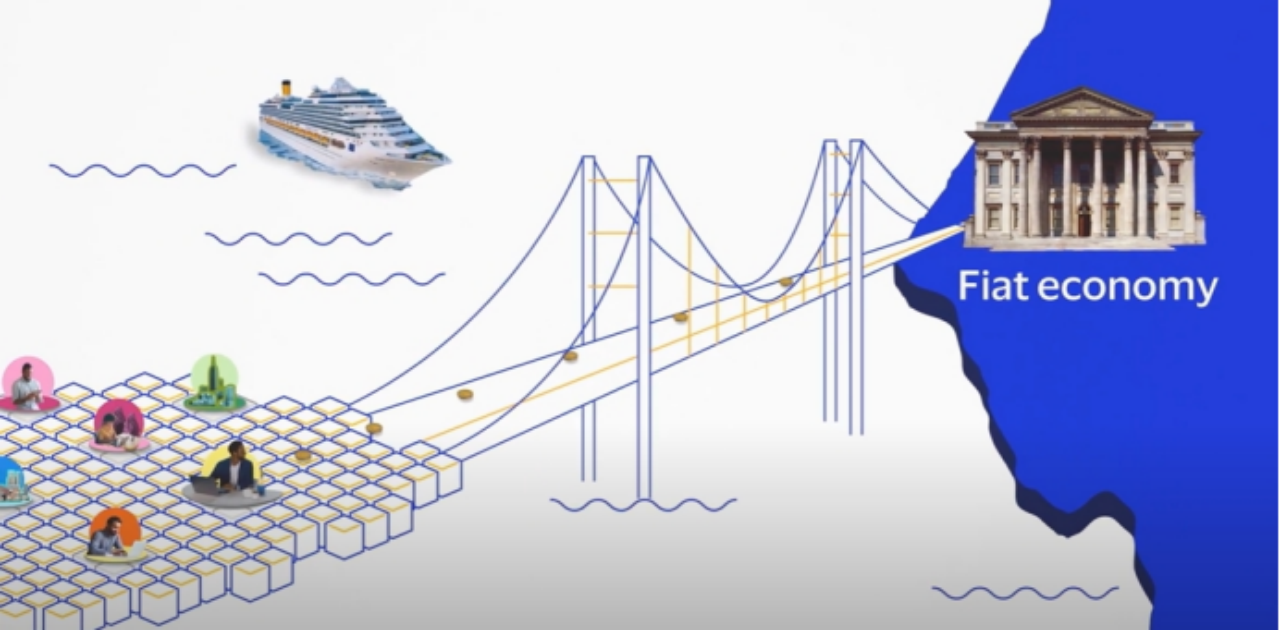
Overall, there are currently a variety of options available for Web3 payments, but when it comes to deposits and withdrawals involving the conversion between fiat currency and cryptocurrency, operators generally need to apply for operating licenses by region. The fees generated by payments vary slightly due to the different business models of the payment methods.
In addition to deposit and withdrawal payments, some centralized exchanges and payment institutions have collaborated with card organizations like Visa and Mastercard to issue debit and credit cards. These cards possess dual functionalities, enabling both deposit and withdrawal payments as well as cryptocurrency payments.
2.2 Cryptocurrency Payments
As the acceptance of cryptocurrencies continues to grow, Web3 payments are making their way into traditional markets such as e-commerce (for online shopping), the gig economy (for contracts and freelancers), cross-border remittances, travel bookings, and online gaming (for in-game item exchanges). They utilize cryptocurrencies for online spending and remittances, instead of relying on the outdated infrastructure of traditional banks or third-party payment institutions.
Currently, cryptocurrency payments are primarily divided into two categories: one involves payments between traditional off-chain entities, and the other involves payments within native on-chain scenarios.
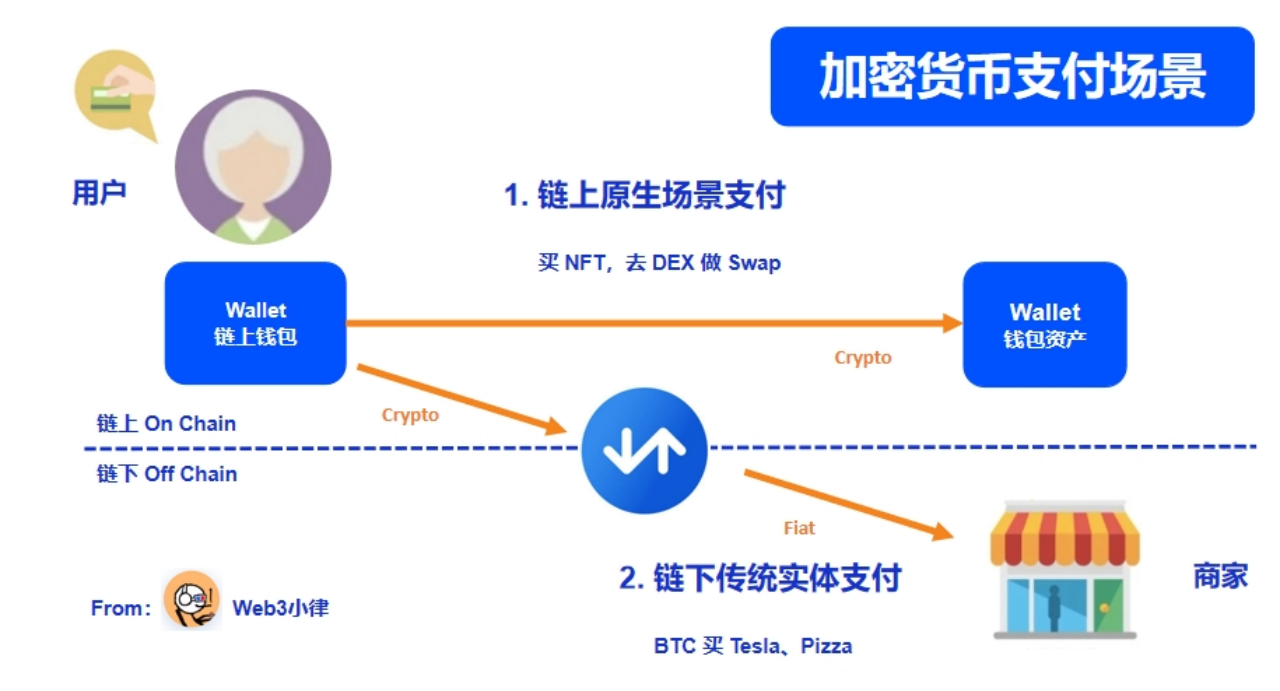
2.2.1 Cryptocurrency Payments—Off-Chain Traditional Physical Payments
According to a report by PYMNTS and BitPay in 2022, which surveyed over 2,330 online merchants with annual sales exceeding $250 million, approximately 85% of large retailers (with annual revenues over $1 billion) now offer cryptocurrency as a payment option. Among all the merchants surveyed, half have already adopted cryptocurrency payments, and among those who haven't, 42% are planning to do so. The report also found that most merchants use non-native crypto wallets, such as PayPal and Venmo, to support crypto payments.
To meet the growing demand for Web3 payments, leading payment giants such as Mastercard, Visa, PayPal, Stripe, and Venmo are partnering with cryptocurrency companies to offer millions of users the option to use cryptocurrencies as a means of payment. Most major retailers, including Overstock, Microsoft, Expedia, and Starbucks, have also integrated crypto payments, allowing their customers to directly purchase digital and physical goods with cryptocurrencies. Other major companies that have embraced crypto payments include the popular streaming company Twitch, Norwegian Air, Etsy, and Burger King.
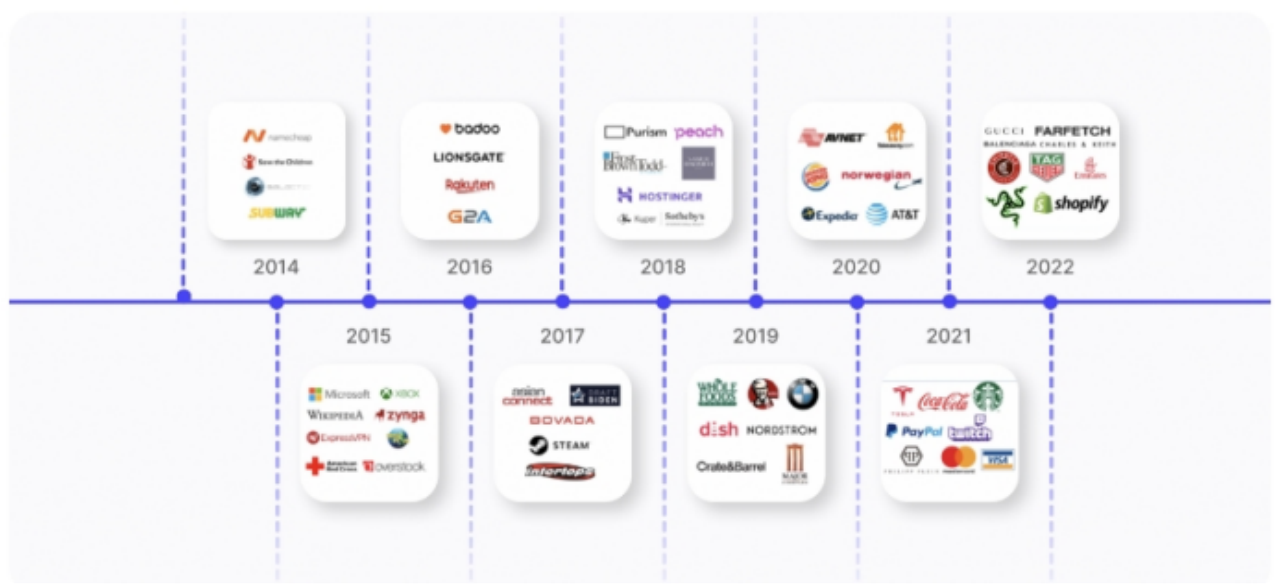
In terms of payments between traditional entities via blockchain, we simulate a scenario where a user spends cryptocurrency, and the merchant receives fiat currency. The flow of funds involves a third-party payment institution that first converts the cryptocurrency into fiat currency through deposit and withdrawal processes, and then makes the fiat currency payment to the merchant.
The most common solution currently available involves the issuance of encrypted bank cards. Centralized exchanges or wallet companies often collaborate with card organizations like Visa and Mastercard to issue encrypted debit/credit cards. Users can make online purchases or swipe their cards offline as long as they hold cryptocurrencies in their platform accounts. During the actual payment process, the issuing company will convert the cryptocurrency into the local fiat currency through a withdrawal payment channel before paying the merchant. We see that the centralized exchange Crypto.com has issued the Crypto.com Visa Card debit card in partnership with Visa. In addition to the functionality of fiat currency payments, it also provides users with the ability to make payments in on-chain cryptocurrencies.
2.2.2 Cryptocurrency Payments - Payments in Native On-Chain Scenarios
In terms of payments in native blockchain scenarios, users pay with cryptocurrency, and merchants accept cryptocurrency.This approach cannot be simply understood as merely peer-to-peer payment transfers based on blockchain technology. It also needs to take into account the trust issues encountered in real-world payment scenarios, which necessitates the implementation through third-party payments.
Taking the case of online shopping as an example, in the context of solving trust issues (trust chains among friends), transactions can be directly facilitated through blockchain peer-to-peer transfers, encompassing user payment, merchant shipping, and user receipt. However, in an online shopping platform without a foundation of trust, who ensures that the merchant will ship the goods after the transfer, and that the received goods match the actual products?
Similarly, we can achieve peer-to-peer transfers between family and friends through the blockchain network. However, what should we do if the transaction counterpart is a stranger? Therefore, we also need a set of account systems linked to the blockchain's settlement system to facilitate the flow of physical goods offline and payment settlements online.
Therefore, third-party payment institutions that offer cryptocurrency payment products are needed to address the issues mentioned above. This includes the cryptocurrency payment protocol shown in the diagram, the payment core system, front-end product interaction, and the corresponding support modules. We can see Ripple and Stella's exploration in this area.
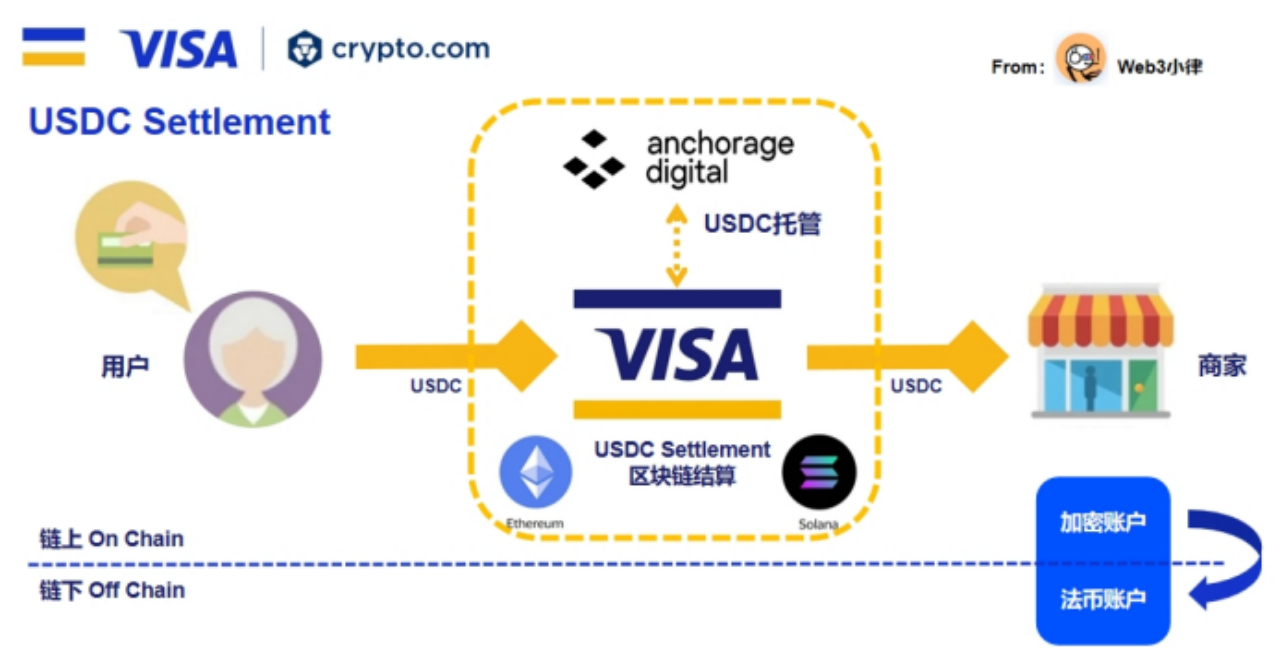
Visa recently introduced a settlement solution based on the stablecoin USDC, which has been applied in the case of Crypto.com. Previously, in scenarios where users spent cryptocurrencies and merchants received fiat currency, Crypto.com had to convert the cryptocurrencies paid by users into fiat currency and then pay the merchants through traditional payment channels. Settling through traditional payment channels means increased participants, transaction fees, costs, and complexity, and it restricts Crypto.com from executing settlements outside of banking hours.
Through Visa's USDC settlement scheme, the need for currency exchange and traditional payment steps in transactions is directly eliminated, enabling real-time, global settlements 24/7/365 via blockchain. This flexible settlement method, which does not require currency exchange, opens up new business scenarios for Crypto.com, such as merchant cryptocurrency payment gateways and blockchain-based cross-border payments.
Visa's USDC settlement solution can also be applied to cross-border remittances. The cross-border remittance market, currently valued at nearly $100 billion, is plagued by the high costs of traditional payment methods, which charge up to 8% of the total transaction amount in fees. In contrast, Web3 cross-border remittance products like Strike's Send Globally leverage the Bitcoin Lightning Network to offer an affordable alternative to traditional cross-border remittances, with fees ranging from only 0.01% to 0.1% of the transaction amount.
This settlement method, combined with the use of stablecoins, can reduce the cost of traditional cross-border payments by 80%. This means that for a $500 remittance, the transaction cost of on-chain cryptocurrency payments and cash in/out payments is only $4.8, significantly lower than the average cost of cross-border remittances, which hovers around $20. In 2022, cross-border remittances to laborers neared $800 million, and remittances based on Web3 payments could save the industry between $40 billion and $64 billion in costs annually.
3. Industry Giants Lay Out Plans for Web3 Payments
Industry giants are gradually opening up and integrating Web3 payment services and scenarios around their core businesses such as trading, payments, communication, and social networking. This includes wallets, custody, payments, transactions, and stablecoins, ultimately covering their entire ecosystem to form a logical loop. The following outlines the strategies of Paypal, Coinbase, and MetaMask in this area.
3.1 PayPal's Web3 Payment Strategy: Payments, Wallet Custody, and Stablecoins
In the previous article, "Paypal's Stablecoin Hopes to Lead the Crypto Industry Towards Mainstream," we introduced PYUSD, a stablecoin launched by Paypal on August 7, 2023. As the only stablecoin supported within the PayPal ecosystem, it aims to connect PayPal's existing 431 million users, providing a seamless bridge between fiat currency and cryptocurrency for consumers, merchants, and developers in the Web2 space.
3.1.1 Implementation Path for Deposit and Withdrawal Services
By reviewing the Paypal CryptoCurrency user agreement, we can see that the PYUSD stablecoin plays a crucial role as a bridge in facilitating payments between Web2&3, Paypal accounts, and crypto custody wallet accounts.
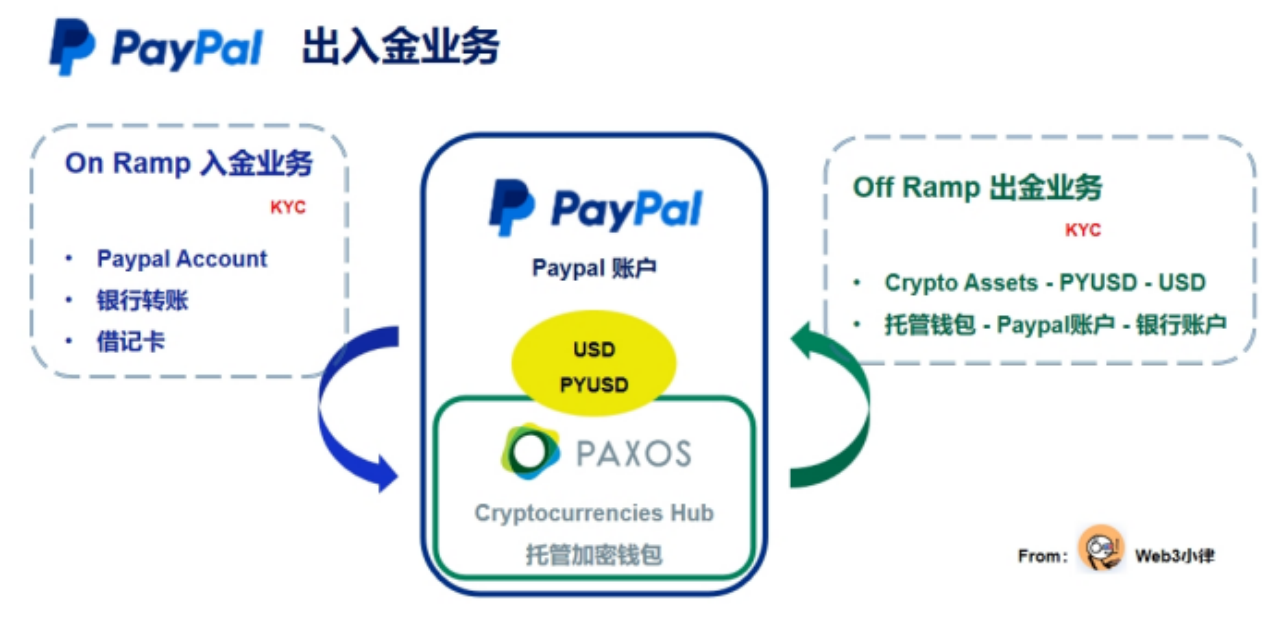
As illustrated above, Paypal uses the PYUSD stablecoin as a bridge for exchanges between fiat currency and cryptocurrency. Whether it's for deposit services, withdrawal services, or crypto payment services, transactions are completed through the USD - PYUSD - Crypto Asset chain, and vice versa. For instance, in scenarios where cryptocurrency is used to pay for merchant services, the first step is to sell the Crypto Asset for PYUSD/USD, which is then used to make payments to the merchant in PYUSD/USD.
For fiat currency transactions, PayPal uses its accounts, while for cryptocurrencies, PayPal facilitates this through the creation of a Cryptocurrencies Hub wallet under the PayPal account. This wallet is managed by PYUSD issuer Paxos, meaning users relinquish control of their assets (private keys). The PayPal User Agreement explicitly states: "You will not hold the digital Crypto Assets themselves in your Crypto Asset balance / You do not own any specific, identifiable, Crypto Asset."
From this, we see thatPaypal has laid out a framework for Web3 payments by bridging the gap between fiat and cryptocurrency through payment channels, issuing stablecoins as a medium of exchange, and establishing a Paypal account wallet system. This allows for a logical closed loop within its own ecosystem.
Building on this foundation, Paypal can leverage its strengths in the payment industry to extend deposit capabilities to cryptocurrency wallets like MetaMask and Ledger, as well as centralized exchanges such as Kraken. Additionally, in the withdrawal feature announced by Paypal on September 12, 2023, support is also extended to wallets, DApps, and NFT market platforms.
With channels, tools, and infrastructure all in place, the key is how to guide Paypal's existing 431 million users into Web3, leading Web3 towards true mass adoption.
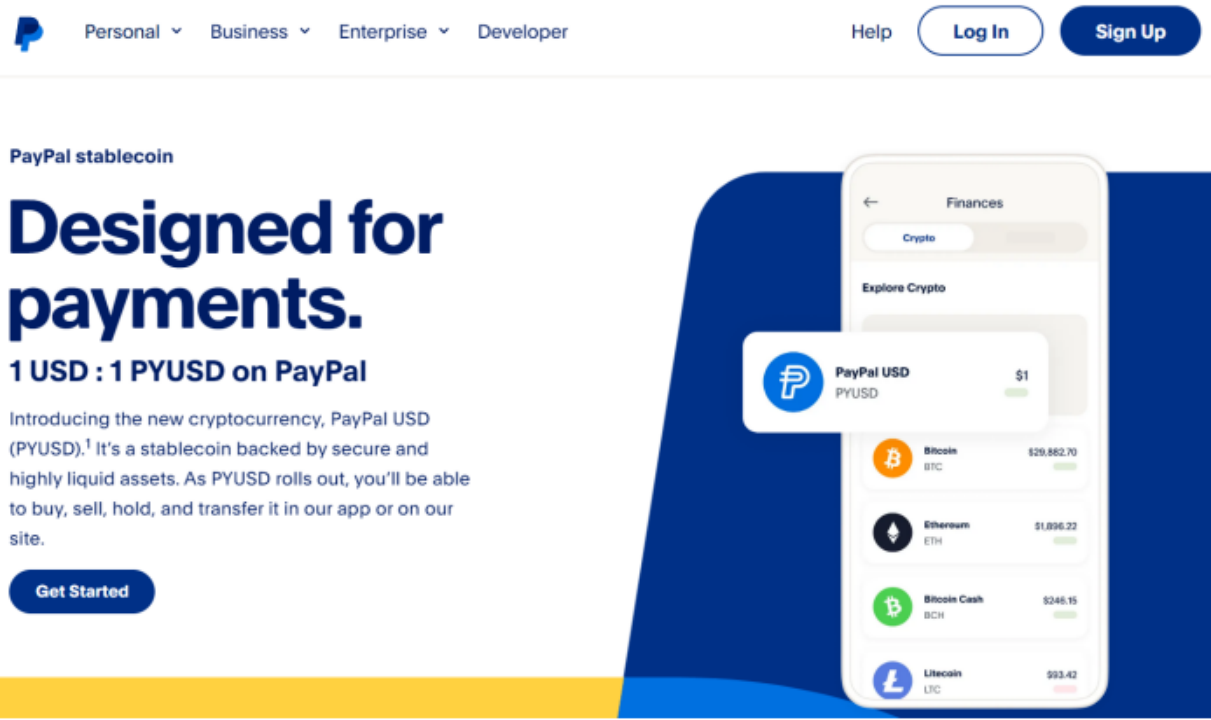
3.1.2 Traditional Payment Companies Poised for Action
We've observed that Paypal's approach is particularly well-suited for traditional payment companies to emulate, such as Stripe and Square, which are already engaged in deposit and withdrawal services, as well as transaction exchanges. For instance, Stripe announced in December 2022 that it would offer cryptocurrency deposit services, and Block (the parent company of Square) offers BTC trading services through its Cash App, in addition to its basic peer-to-peer payment functionality.
Traditional payment companies have essentially achieved compliance in local payment operations and obtained the necessary qualifications and licenses. The question of when and how they will venture into Web3 payments is merely a matter of timing and pace. In contrast, newcomers like X (formerly Twitter) are actively applying for Money Transmitter Licenses (MTL) across various states in the U.S. to meet the requirements for compliant payments.
3.2 Coinbase's Web3 Payment Layout - Trading, Custody, and Payments
Coinbase, as the world's most compliant centralized exchange, offers many regulatory paths worth emulating. We observe thatCoinbase, by strategizing around Web3 payments, can create a logical closed loop within its own ecosystem. This includes payment channels for deposits and withdrawals, Commerce merchant payment solutions, stablecoin transaction mediums (USDC), cryptocurrency custody wallets and non-custodial Wallets, as well as the core trading functionalities of the exchange itself.
3.2.1 Trading as the Core, Payment as the Auxiliary
Although centralized exchanges obtaining payment licenses is primarily for the compliance of their own trading operations, acquiring these licenses also opens up funding channels and payment gateways. Due to regulatory uncertainties, overly relying on third-party funding and payment channels, such as the previously collapsed Slivergate Bank and Signature Bank which was forcibly liquidated by regulators, can lead to business instability. Therefore, we see many exchanges developing their own payment services, such as Binance Pay, Coinbase Pay, Gate Pay, etc.
In the Licenses & Disclosures section, we see that Coinbase has obtained money transmission licenses (MTL) in most states in the United States. Notably, Coinbase was granted a BitLicense by the New York State Department of Financial Services (NYDFS) in 2017, becoming the first regulated Bitcoin exchange in the US, capable of offering services such as buying, selling, receiving, and storing Bitcoin for users in New York.
Outside the United States, Coinbase is actively expanding into international markets and has successively obtained the EMI license in the UK, the VASP license in Ireland, the VASP license in Germany, and the DPT license in Singapore. Consequently, Coinbase, with its trading operations as the entry point, is gradually extending its trading services and payment channels to cover numerous jurisdictions worldwide.
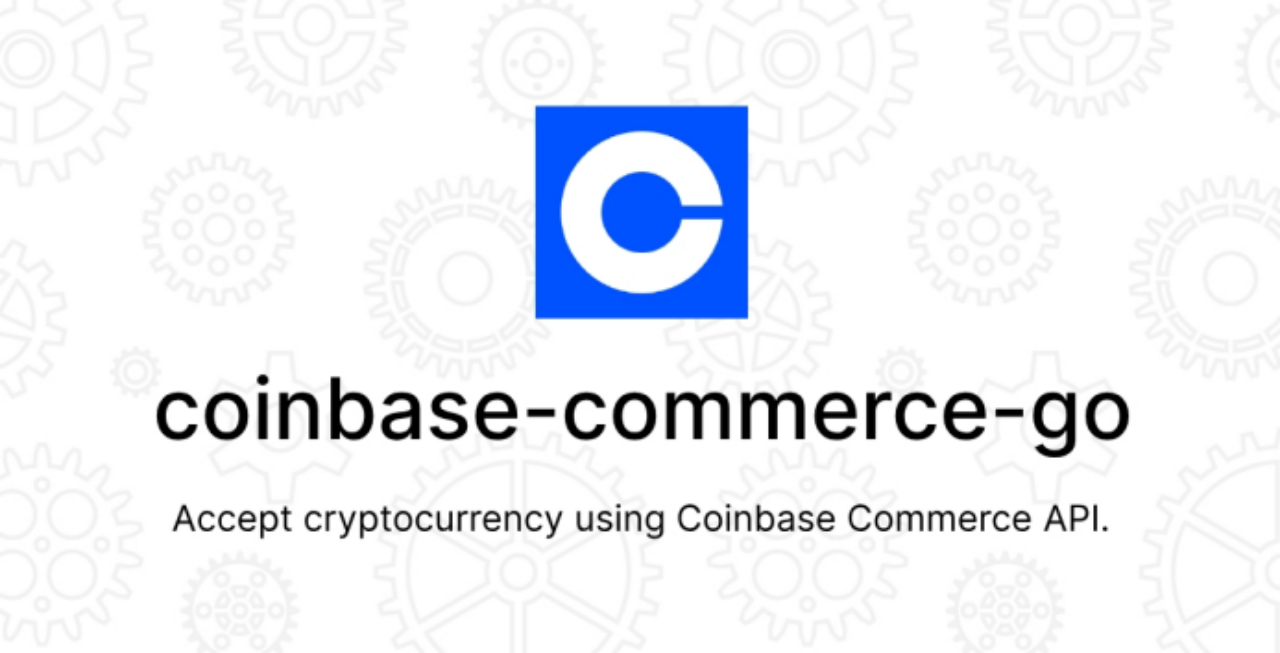
3.2.2 Custodial Services and Non-Custodial Wallets
Coinbase Custody Trust Company, LLC, regulated by the New York State Department of Financial Services, is the principal entity through which Coinbase offers custodial services. We observe that existing Bitcoin spot ETFs primarily partner with Coinbase for asset custody.
According to data from CoinGecko, an analysis included in the ETF filing submitted by BlackRock estimates that 56% of the $129 billion in Bitcoin transactions in the United States were conducted on Coinbase. As the development of Bitcoin spot ETFs progresses, this percentage is expected to increase further. Consequently, Coinbase stands to gain significantly and become the biggest winner in this competition.
For non-custodial wallets like Coinbase Wallet, since users independently control their assets (private keys) and interact directly with the payment system, Coinbase Wallet itself, similar to MetaMask, would not be classified as an MSB (Money Services Business) by FinCEN.
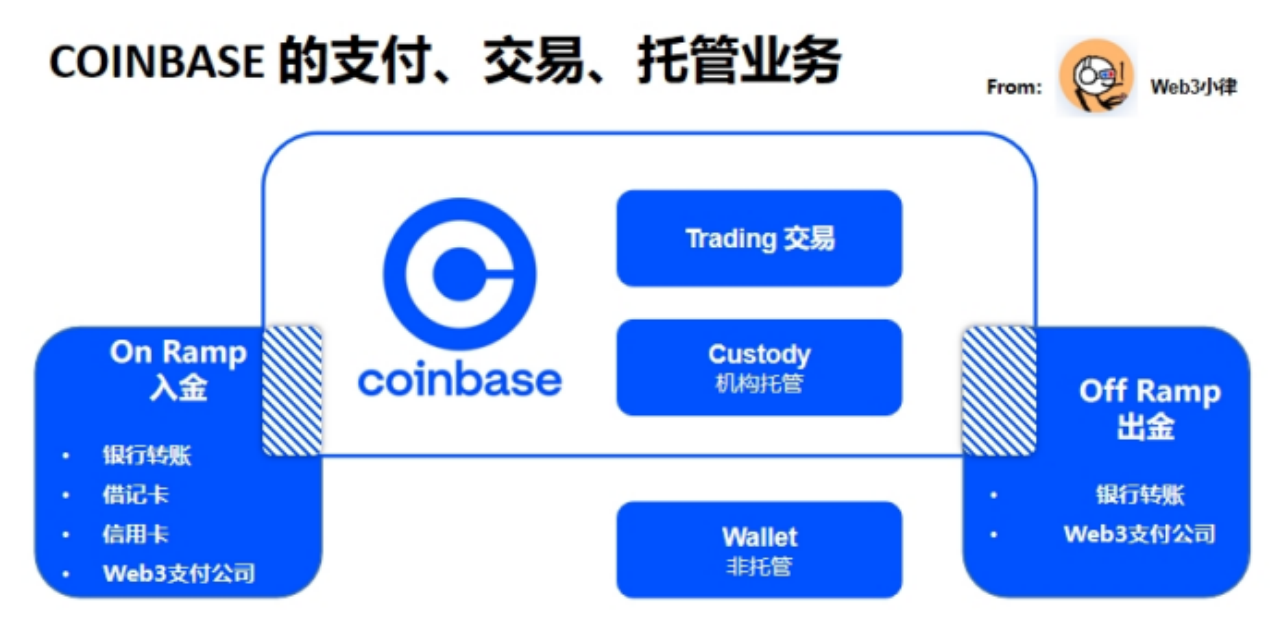
From this, we observe that Coinbase, leveraging its compliance advantage in trading operations, has established a seamless payment channel for deposits and withdrawals, a stablecoin trading medium (USDC), crypto asset custody wallets and non-custodial Wallets, as well as the core trading functionalities of the exchange itself, thereby creating a logical closed loop within its own ecosystem.
Web3 payment services are good, but the key lies in the exchange's core business and profit contribution of Coinbase.
3.3 MetaMask's Web3 Payment Layout - Wallet and Aggregation
Over the past year, we've observed MetaMask continuously rolling out new features. The current MetaMask Portfolio DApp now integrates functionalities such as Sell, Buy, Stake, Dashboard, Bridge, and Swap, facilitating users in conveniently managing their assets and executing unified on-chain asset operations. Additionally, MetaMask has recently launched the Snaps version, incorporating third-party public chain plugins.
MetaMask's inherent advantage lies in its nearly 30 million monthly active users. According to data disclosed by Consensys, MetaMask's total user base has reached 100 million, connecting to 17,000 DApps, with daily interactions reaching 244,000. A report by CoinGecko shows that as of August 2023, MetaMask's download count has reached 22.66 million.
In the foreseeable future, it's expected that MetaMask will evolve into a super wallet traffic portal, orchestrating wallet traffic to distribute across various DApps, offering vast potential for commercial innovation.
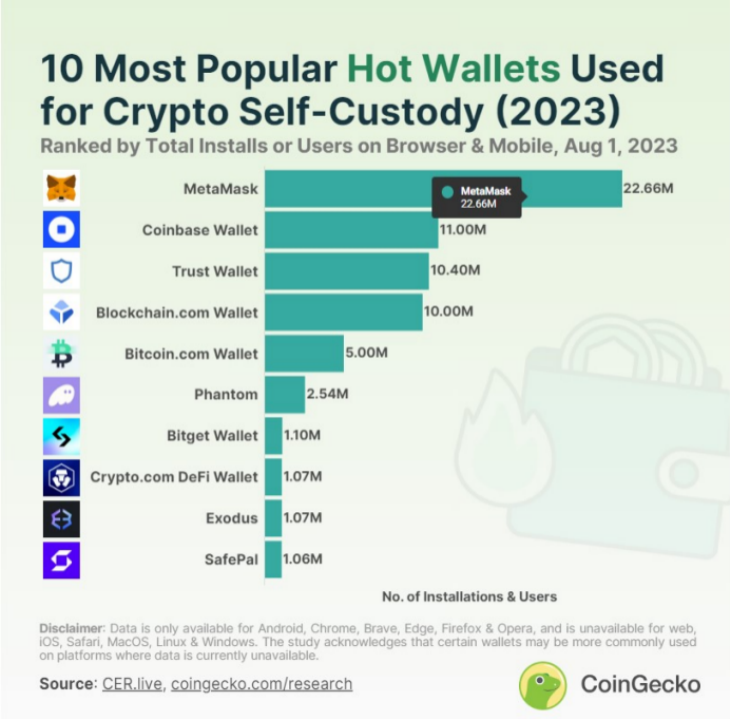
3.3.1 The launch of Sell has enabled the functionality of deposits and withdrawals.
On September 5, 2023, MetaMask launched its latest feature, "Sell," allowing users to exchange cryptocurrencies for fiat currencies through the MetaMask Portfolio and transfer funds to their bank accounts. For compliance reasons, this feature is currently available only in the US, UK, and certain parts of Europe, and only supports exchanges in USD, EUR, and GBP. MetaMask stated that initially, it will only support ETH on the Ethereum mainnet, with plans to expand to other native tokens on Layer2 networks in the near future.
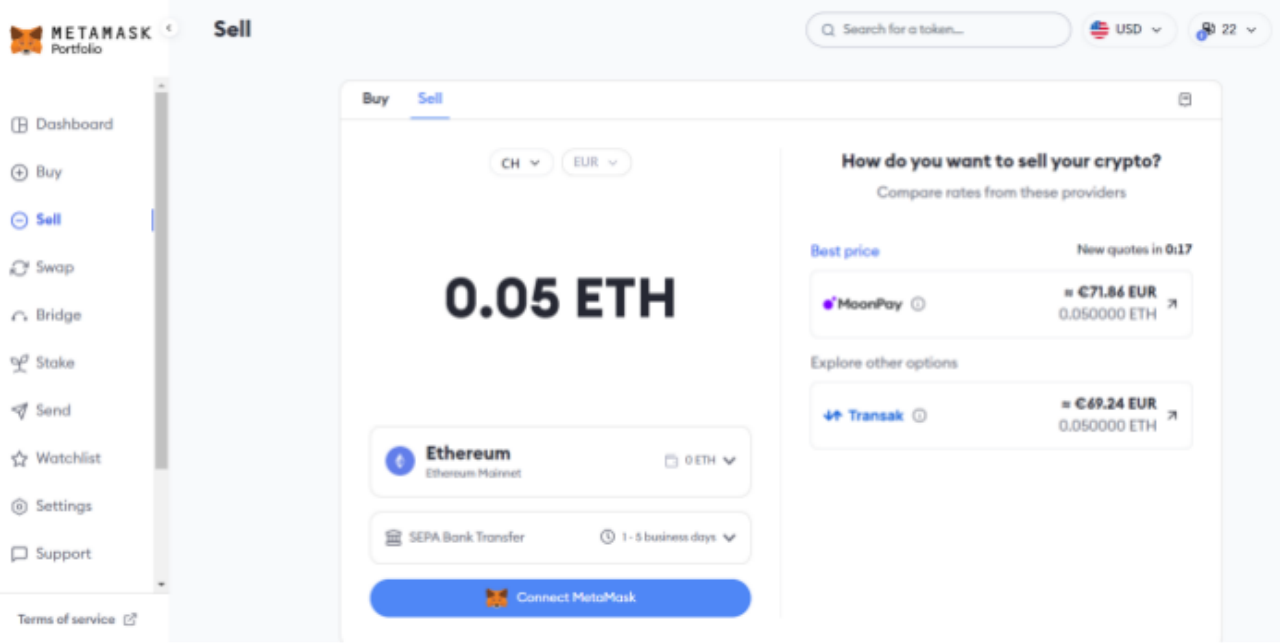
After selecting their region, users input the amount of ETH they wish to sell and choose a quote from multiple service providers, then link their bank account. According to official statements, MetaMask has partnered with cryptocurrency cash-out service providers such as MoonPay, Sardine, and Transak. However, currently, only MoonPay and Transak are offering this service, and it requires KYC verification.
The "Sell" withdrawal feature was launched five months after the "Buy" deposit feature went live on MetaMask. The deposit feature allows users to fund their accounts using bank accounts, PayPal, debit cards, and credit cards.
Non-custodial wallets like MetaMask, which are independently controlled by users (private keys) and interact directly with payment systems, only provide communication or network access services to support money transfer services, are not considered Money Services Businesses (MSBs) under FinCEN regulation. However, Moonpay, which provides payment channels for MetaMask, is considered an MSB.
3.3.2 Independent Third-Party Payment Company Moonpay
MoonPay is currently a leading project in cryptocurrency deposits and withdrawals, boasting over 5 million registered users. In terms of coverage, MoonPay supports crypto payments in more than 160 countries and regions, and facilitates the exchange of over 80 types of cryptocurrencies and more than 30 types of fiat currencies. As for payment methods, MoonPay currently accepts credit and debit cards, mobile payments, and account-to-account transfers among other channels. Uniswap has also previously integrated Moonpay as one of its deposit channels.
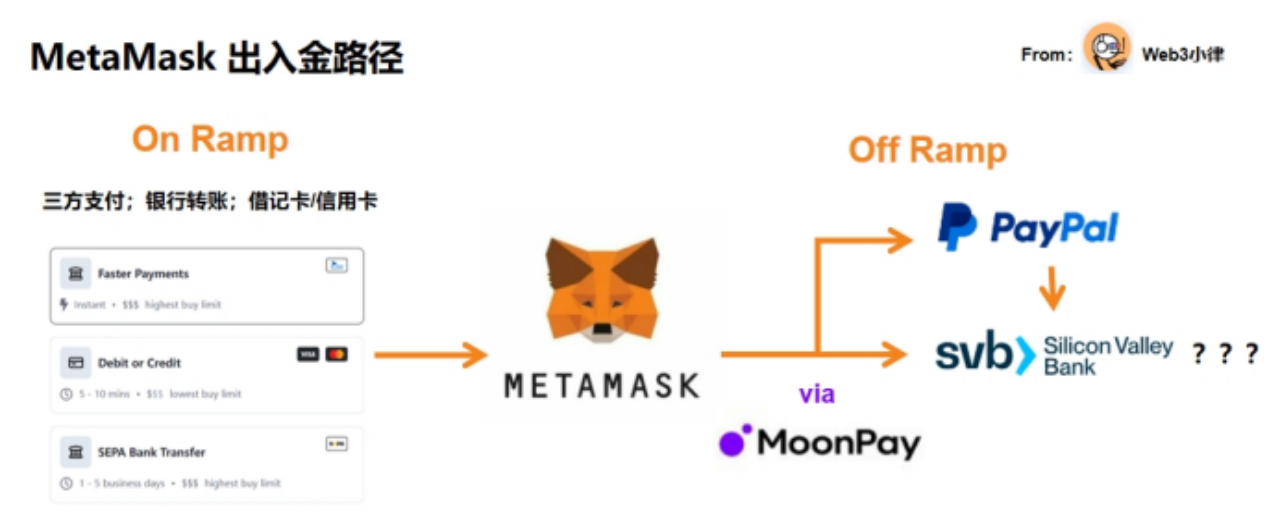
After integrating independent third-party payment companies like Moonpay, MetaMask has been able to establish a payment channel for deposits and withdrawals, a non-custodial wallet, and a variety of transaction functionalities (such as Swap, Bridge, Stake, etc.) on its portfolio page, essentially creating a logical closed loop.
3.3.3 Snaps version
On September 13, 2023, MetaMask released its Snaps version, which supports wallet integration for non-EVM (Ethereum Virtual Machine) chains including Solana, Sui, Aptos, Cosmos, and Starknet. Currently, there are 34 Snaps in the beta testing phase. In essence, MetaMask has made some of its functionalities open-source, allowing third-party developers to extend the MetaMask wallet in the way they desire, aiming to provide users with a more personalized or diverse trading experience.
In the past, when users wanted to interact with various public blockchains, they had to download the corresponding wallet plugins, which not only provided a poor user experience but also indirectly increased many security risks. Now, MetaMask has opened up a set of Snaps API access standards, allowing third-party public chain wallet providers to overcome technical challenges and integrate on their own. MetaMask is only responsible for the audit of the integration, while the rest of the development work is completed by third-party developers.
With this, users only need to download the MetaMask wallet and install third-party public chain plugins to achieve free movement across various public chain networks, with enhanced security. This is a very smart move in ecosystem integration, further solidifying its leading position in the plugin wallet market.
MetaMask's inherent advantage lies in its nearly 30 million monthly active users. In the foreseeable future, it's expected that MetaMask will evolve into a super wallet traffic portal, managing wallet traffic to distribute to various DApps. This opens up significant commercial possibilities.
IV. Regulatory Compliance in Web3 Payments
Due to the openness and innovation of cryptocurrency assets, it's challenging to uniformly define their attributes. Currently, most jurisdictions do not have a comprehensive regulatory framework specifically for cryptocurrency assets. **In practice, regulating Web3 payments not only requires compliance with cross-border payments and money transfer services but also with cryptocurrency business operations.** Furthermore, given the inherent global circulation of cryptocurrency assets, Web3 payments will face exceptionally complex compliance challenges across multiple legal jurisdictions worldwide. This also poses a significant challenge for regulators in each jurisdiction.
Despite this, we can still observe some jurisdictions actively exploring Web3 payments. For instance, crypto-friendly Switzerland has clearly defined "Payment Tokens"; similarly, Singapore also has a definition for "Payment Tokens" and recently released a regulatory framework for stablecoins; the European Union's MiCA legislation also clearly defines "E-Money Tokens".The continuous clarification of these regulatory definitions will grant cryptocurrencies a legitimate and effective status, thereby further propelling the development of the Web3 payment industry and leading the Web3 sector towards true mass adoption.
Compliance is the foundation upon which traditional giants stand, which is why we see them initially limiting their Web3 payment services to certain regions. For instance, MetaMask's Sell withdrawal service (supported by Moonpay) is currently only available in the US, UK, and parts of Europe, while Paypal's stablecoin is also limited to US users.Although projects can only engage in Web3 payment services in compliance with standards after meeting licensing, qualification, and permission requirements, this also represents a major barrier for participants in Web3 payment projects.
Due to the complexity of Web3 payments, which involve encrypted assets, payments, asset custody, stablecoins, anti-money laundering/counter-terrorism financing, and other legal compliance issues, the legal landscape is exceptionally intricate. The following will briefly outline the legal regulations concerning Web3 payments in major jurisdictions, to see how the giants are building legal compliance barriers.
4.1 United States
The primary regulatory body for Web3 payments in the United States is the Financial Crimes Enforcement Network (FinCEN), which operates under the U.S. Department of the Treasury. FinCEN is primarily responsible for overseeing and implementing work related to Anti-Money Laundering (AML), Counter-Terrorist Financing (CFT), and Know Your Customer (KYC) regulations. Additionally, it is tasked with collecting and analyzing financial transaction information, tracking suspicious individuals and activities through the study of mandatory disclosures by financial institutions.
FinCEN's authority is derived from the United States' Bank Secrecy Act (BSA), which treats cryptocurrencies as "currency". In 2019, FinCEN issued guidelines (Application of FinCEN’s Regulations to Certain Business Models Involving Convertible Virtual Currencies), establishing regulations related to crypto asset payments.
The 2019 Guide defines "money transmission" as the act of receiving currency (or the value of other monetary substitutes) from one party and sending all or part of it to another party. In this definition, "monetary substitutes" include money orders, stored value cards, and cryptocurrencies. In most cases, any "company" engaged in the business of money transmission will meet the definition of a "Money Service Business" (MSB) under the BSA, and will need to comply with BSA and FinCEN regulations, fulfilling compliance obligations.
A general summary of the 2019 guidelines for determining whether it is an MSB:
Whether the user's assets (private keys) are controlledCentralized exchanges and custodial wallet providers that serve U.S. customers, by virtue of being able to control user assets (private keys), are classified as Money Services Businesses (MSBs). Conversely, non-custodial wallets like MetaMask, as well as Decentralized Exchanges (DEXs) that only facilitate matchmaking transactions, where users independently control their assets (private keys) and interact directly with the payment system, or those that merely provide communication or network access services to support money transmission services, are not considered MSBs.
The monetary transfer nature of the businessPayment companies that provide services to users in the United States, such as Moonpay, Paypal, Stripe, Square, are engaged in the business of money transmission and are classified as MSBs (Money Services Businesses).
Companies classified as MSBs not only need to comply with BSA and FinCEN regulations and fulfill compliance obligations but also need to obtain Money Transmitter Licenses (MTL) in accordance with state money transmission laws. While obtaining an MSB license in the United States is relatively easy, applying for an MTL license can be time-consuming, requiring about two years and millions of dollars in legal consulting fees to secure an MTL license in various states.
The BitLicense is a cryptocurrency license created by the New York State Department of Financial Services under the New York Financial Services Law. It is designed to regulate crypto asset institutions and related trust companies (a New York State limited purpose trust company) within the state. Licensees must comply with the BitLicense regulatory framework, which includes consumer protection, anti-money laundering compliance, and cybersecurity guidelines. Previous recipients of the BitLicense include XRP II, Circle Internet Financial, Gemini Trust Company, itBit Trust Company, and others.

This is also why we see in the news that X (formerly Twitter) is actively applying for Money Transmitter Licenses (MTL) in various states in the U.S. For X (formerly Twitter) to emulate WeChat, it inevitably requires a payment system similar to WeChat's. And for payment companies that have already obtained licenses in various states, this will be their core barrier to operating Web3 payment businesses in the U.S.
4.2 United Kingdom
Companies looking to launch Web3 payment services in the UK must obtain an E-Money Institution (EMI) license issued by the Financial Conduct Authority (FCA). We've seen entities like Coinbase securing an EMI license as early as 2018, allowing them to expand their cryptocurrency operations within the EU.
Interestingly, Aave, a decentralized lending platform based in London, also obtained an EMI license in 2020. It is reported that this move is a compliance measure taken by Aave to attract more users into DeFi, possibly also due to the strict consumer protection compliance requirements in the UK.
Before Brexit, holders of the UK EMI license were unrestricted by time or field of activity within the European Economic Area (EEA), allowing them to offer any form of service. After Brexit, more companies shifted their focus towards the more neutral and friendly Ireland.
4.3 Ireland/European Union
In 2021, Ireland introduced a registration system for Virtual Asset Service Providers (VASP), overseen by the Central Bank of Ireland, to ensure companies meet the requirements for Anti-Money Laundering (AML) and Counter-Terrorism Financing (CTF). Following Coinbase's acquisition of an EMI license authorized by the Central Bank of Ireland, Coinbase Ireland Limited obtained the VASP license in 2022. This license allows Coinbase to issue electronic money, provide electronic payment services, and process electronic payments for third parties.
Similarly, after obtaining the EMI license in the UK, Moonpay was registered as a VASP by the Central Bank of Ireland in 2023. Its CEO stated, "We believe that registering as a VASP in Ireland first, and eventually applying for registration under the EU's MiCA, will provide a significant competitive advantage for the company to enter the EU market compliantly."
The European Union's "Markets in Crypto-Assets Regulation" (MiCA) has been passed by the European Parliament and is expected to come into effect in 2024. Broadly speaking, MiCA applies to all entities involved in the issuance of crypto-assets, as well as those providing related services within the EU: (1) issuers of various types of crypto-assets, including E-Money Tokens, Asset-Referenced Tokens, and other Tokens; (2) various crypto-asset services and service providers, including wallet custody services, deposit and withdrawal services, exchange services, asset management services, investment advisory services, etc.
MiCA fills the gaps in the current EU financial regulatory framework. Once implemented, it will create a unified crypto asset regulatory framework within the EU, directly forming a large crypto asset market that spans 27 countries and affects 450 million EU citizens. Since obtaining a VASP license in one EU member state allows for business operations across the entire EU region, regions with the most lenient cryptocurrency regulations in the EU, like Lithuania, have become the preferred registration destinations for many centralized exchanges and payment institutions.
4.4 Hong Kong
With the passage of the Hong Kong VASP system, all centralized crypto asset exchanges operating in Hong Kong or actively promoting their services to Hong Kong investors, regardless of whether they offer security token trading services, will need to be licensed by the Hong Kong Securities and Futures Commission and be subject to its regulation.
At the same time, the VASP system requires centralized exchanges to "safely custody client assets," meaning that platform operators must hold client funds and crypto assets in trust (TCSP trust license) through a wholly-owned subsidiary. This implies the need for a TCSP license to independently custody investors' assets, to prevent cases of self-dealing.
The full name of TCSP license is Trust or Company Service Providers. Since traditional banks can only hold legal tender assets, the custody of crypto assets can currently only be placed under trust accounts. This also grants the TCSP trust license a new business scenario.
The Hong Kong High Court has previously made a determination in the case of Re Gatecoin Ltd [2023] HKCFI 914 that crypto assets are considered "property" and explicitly stated that they "can be held in trust". Therefore, any company engaged in the custody of crypto assets must apply for a TCSP license. Exchanges such as OSL, Hashkey Group, and Gate.io all have their own TCSP trust companies. Additionally, the wallet infrastructure and digital asset custody service provider Liminal has also recently obtained a TCSP license.
According to the Anti-Money Laundering Ordinance, any entity operating or intending to operate a money service in Hong Kong must apply for a Monetary Service Operator (MSO) license from the Hong Kong Customs. For Web3 payment services, if a company's related crypto business in Hong Kong includes currency exchange services or remittance services, the service provider needs to obtain an MSO license issued by the Hong Kong Customs.
4.5 Singapore
The Monetary Authority of Singapore (MAS) serves as Singapore's central bank and comprehensive financial regulatory body, also overseeing the Web3 industry. According to the "A Guide to Digital Token Offerings" published by MAS in May 2020, security tokens and payment tokens are regulated under two specific legislations, while utility tokens are not regulated.
For payment tokens, according to the Payment Services Act that came into effect in January 2020, providing Digital Payment Token (DPT) services in Singapore, including direct transaction services for DPTs (such as buying, selling, fiat currency exchange, and coin-to-coin exchange) as well as services that facilitate DPT transactions (such as exchanges, custodial institutions, wallet services, etc.).
The difficulty of applying for this license is relatively high, and in recent years, there has been a particularly cautious attitude towards the crypto sector. However, Singapore offers an indefinite exemption period for the operation rights of DPTs, allowing operations to commence without a license. In 2022, institutions such as Circle, Paxos, Blockchain.com, Coinbase, Luno, Digital Treasures Center, Crypto.com, and Genesis were successively granted DPT licenses.
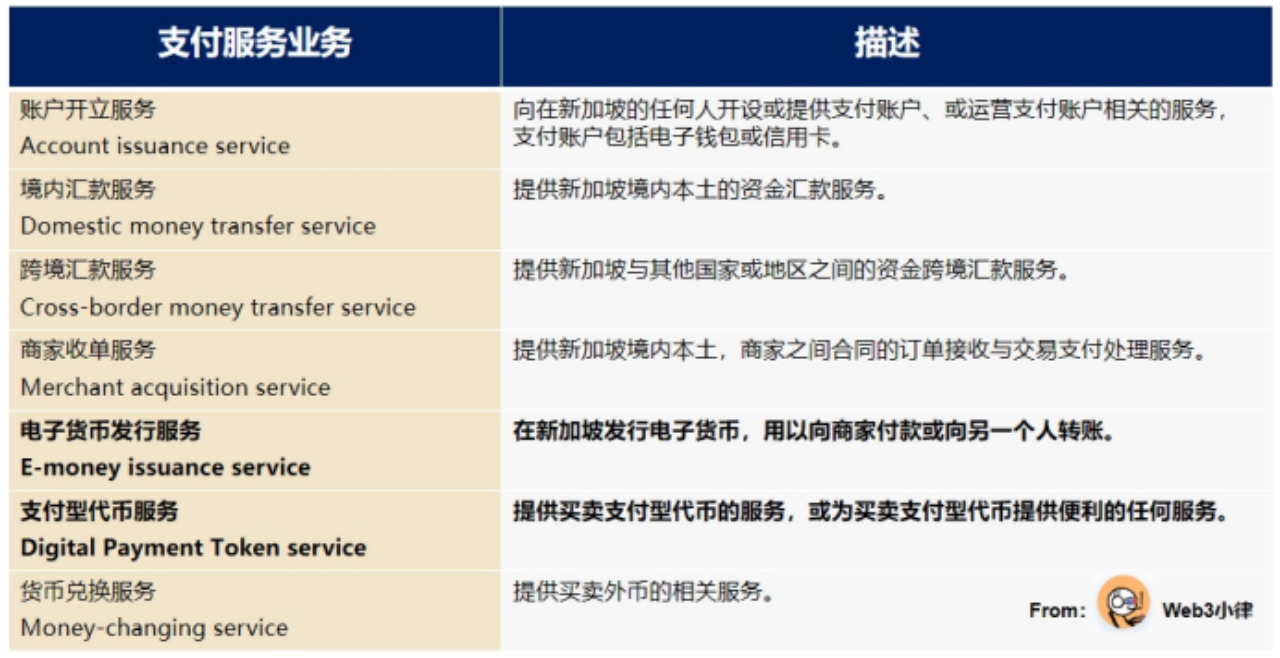
V. The Future of Web3 Payments
From a market perspective, this remains a highly desirable blue ocean market. **According to statistics, there are currently 1.7 billion people worldwide without bank accounts, yet in dire need of financial services.** Countries with high inflation, a majority of the population lacking banking services or with insufficient banking services, or where the traditional financial system is deemed unreliable, have witnessed a surge in crypto payments due to these innovations. The sheer number of over 420 million cryptocurrency owners globally is enough to demonstrate that the cryptocurrency industry is far from speculative; it is a thriving and rapidly growing sector.
From the perspective of innovative development, the current efforts to meet the growing demand for cryptocurrencies involve continuous innovation and optimization of Layer 2 scalability solutions, stablecoins addressing the volatility of cryptocurrencies, compliance asset management solutions by wallet service providers and custodial institutions to ensure asset security, and payment solutions for deposits and withdrawals by Web3 payment companies to tackle merchant receivables and mobile payment issues. These burgeoning technological innovations lay a solid foundation for Web3's march towards mass adoption.
Looking back at the implementation paths of Web3 payments by giants such as PayPal, Coinbase, MetaMask, as well as their strong traffic and scenario entry points, and then imagine the exclusive advantages of players who are going all out, such as X (formerly Twitter) and Telegram.It's not hard to see that after the giants integrate basic functions such as wallets, custody, stablecoins, and payments, they will each form their own vast Web3 crypto ecosystems. In this context, the current crypto market landscape, which is primarily exchange-driven, is bound to change.
Beyond the vast Web3 crypto ecosystems developed by the giants, the interoperability of Web3 products with external systems is also a transformative aspect. Take Web3 wallets as an example; these wallets are tools closely integrated with the DApp ecosystem, providing direct access and functionality for using DApps. Currently, OKX Web3 wallet users can access over 5,500 DApps, and the wallet has already integrated more than 500 DApps. Not to mention, MetaMask boasts nearly 30 million monthly active users, and the MetaMask Portfolio DApp has aggregated functions such as Sell, Buy, Stake, Dashboard, Bridge, and Swap.
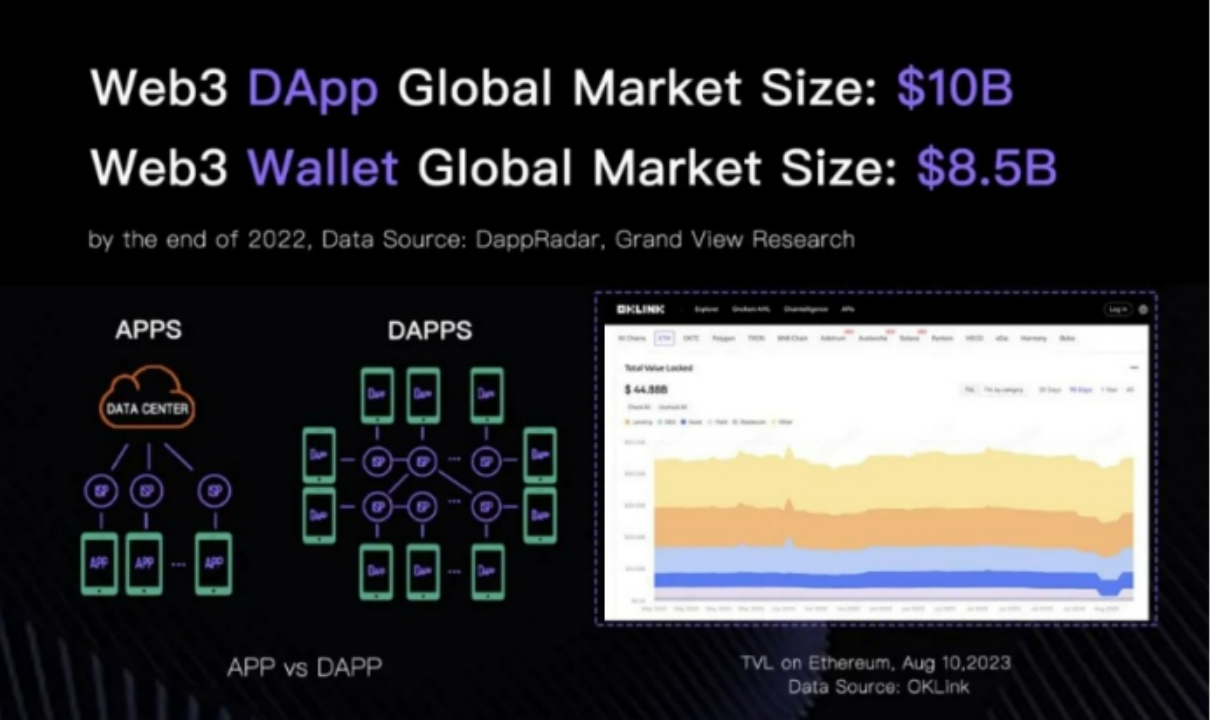
From the perspective of the monetary system, the Bank for International Settlements (BIS) stated in the "Blueprint for the Future Monetary System" that the current monetary system is on the verge of another significant leap.In the era following digitalization, the key to the evolution of the monetary system is tokenization - the process of digitally representing claims on a programmable platform, which can be seen as the next logical step in digital record-keeping and asset transfer.
The future monetary system will leverage tokenization to improve upon the old monetary system and support the new one. By utilizing a new intermediary method (a unified ledger) to serve end-users, it eliminates the manual intervention and reconciliation caused by the separation of traditional message transmission, clearing, and settlement, thereby removing delays and uncertainties.Tokenization can significantly enhance the capabilities of the monetary and financial systems. The future monetary system is expected to unleash new economic growth dynamics through tokenization, which is impractical in the inherent frictions of the current monetary system.
This type of tokenization is not only about the recently popular Real World Asset (RWA) tokenization but also includes the tokenization of currency itself. Tokens not only define assets but also, through their programmability, incorporate the payment logic into the tokens, thereby defining what the assets can be used for.
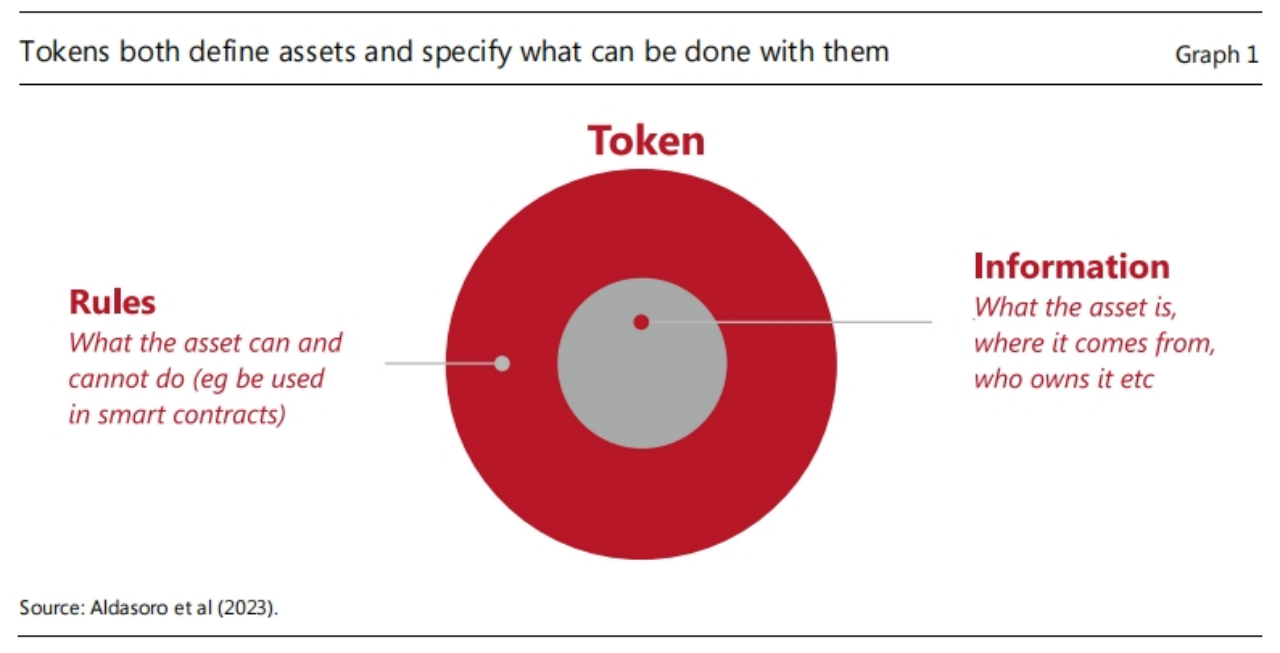
VI. In Conclusion
Without a doubt, in the near future, Web3 payments will become commonplace, potentially completely replacing existing payment methods, whether within businesses or between individuals. At the same time, traditional finance will also connect finance and trade through Web3 payments, making the expression, circulation, trading, programming, and regulation of assets the main value proposition, highlighting efficiency advantages.
The greatest opportunity for cryptocurrencies may not lie in viewing them as cryptocurrencies, but in seeing them as a new payment method. Some believe that the killer application for Web3 has yet to arrive, but it might have already quietly made its entrance: it's payments!
Digitization and tokenization will endow the traditional monetary system with new value, overcoming previously insurmountable boundaries. This could forever change the global economy.
REFERENCE
- ZONFF Research, panoramic interpretation and trend analysis of the Web3 payment track
- Blueprint for the future monetary system: improving the old, enabling the new
- Bing Ventures, Crypto Payments Market Size To Reach Hundreds Of Billion Dollars In Three Years
- TokenInsight, 2021 Digital Assets Payment Industry Research Report
- Ripple & FPC, Blockchain & Crypto in Payments: Transforming the Way Money Moves
- B2BinPAY, How Crypto Payment Solutions Have Changed the Market
- Sygnum Bank, 加密货币作为支付手段:一个不断发展的大趋势
- Celine Wee, On/off Ramps in Web3: an Introductory Guide
- PAYPAL CRYPTOCURRENCY TERMS AND CONDITIONS
- LD Capital: Exploring Coinbase's Investment Logic and Growth Potential
- Ouke Cloud Chain, technology giants are betting heavily, can Web3 wallets become the fulcrum to leverage the industry?
- Visa, Crypto stablecoin settlement
- FinCEN法规对某些涉及可转换虚拟货币的商业模式的应用
- Meng Yan's Reflections on Blockchain: A Decade of Reevaluation in the 'Chain Circle'
- CSDN, [Payment Architecture] Cross-border Payments
- TouBao Research Institute, Ren Jingyi, Cross-border Payments
